Southeast Asia Backpacking Nov.-Dec. 2018
Thailand: scuba diving in the Andaman SeaóPart 2
30 November Andaman Sea
Koh Bon has a submerged pinnacle, and thatís where
we dove. Strong currents made for a shorter dive of about 37 minutes, however,
but we saw the usual abundant undersea life including tuna and trevally out
hunting.
Our late-morning excursion went under at Koh Tachai Plateau,
well to the north of the main Similan Islands, but still in Similan National
Park. We encountered some current among the massive granite blocks and enjoyed
seeing the very colorful hard and soft corals. Abundant fish included angelfish,
bannerfish, batfish, grouper, tuna, and trevally.
In the afternoon we
again visited Koh Tachai Plateau, encountering a cold thermocline near the
bottom and somewhat murky water with a current. We saw giant and bearded moray
eels and the usual abundance of fish.
In the evening we arrived in the
Surin Islands and made a night dive at Coconut Bay. Five Jenkinís rays snoozed
on the sea floor while large crabs and lobsters ventured out from their rocky
crevices. Some fish swam about, including cardinal fish and masked
porcupinefish, both of which have very large eyes. And anytime that I covered my
flashlight and waved my hand, I could see the tiny green sparkles from
bioluminescent plankton.

A dazzling
beach in the Similan Islands
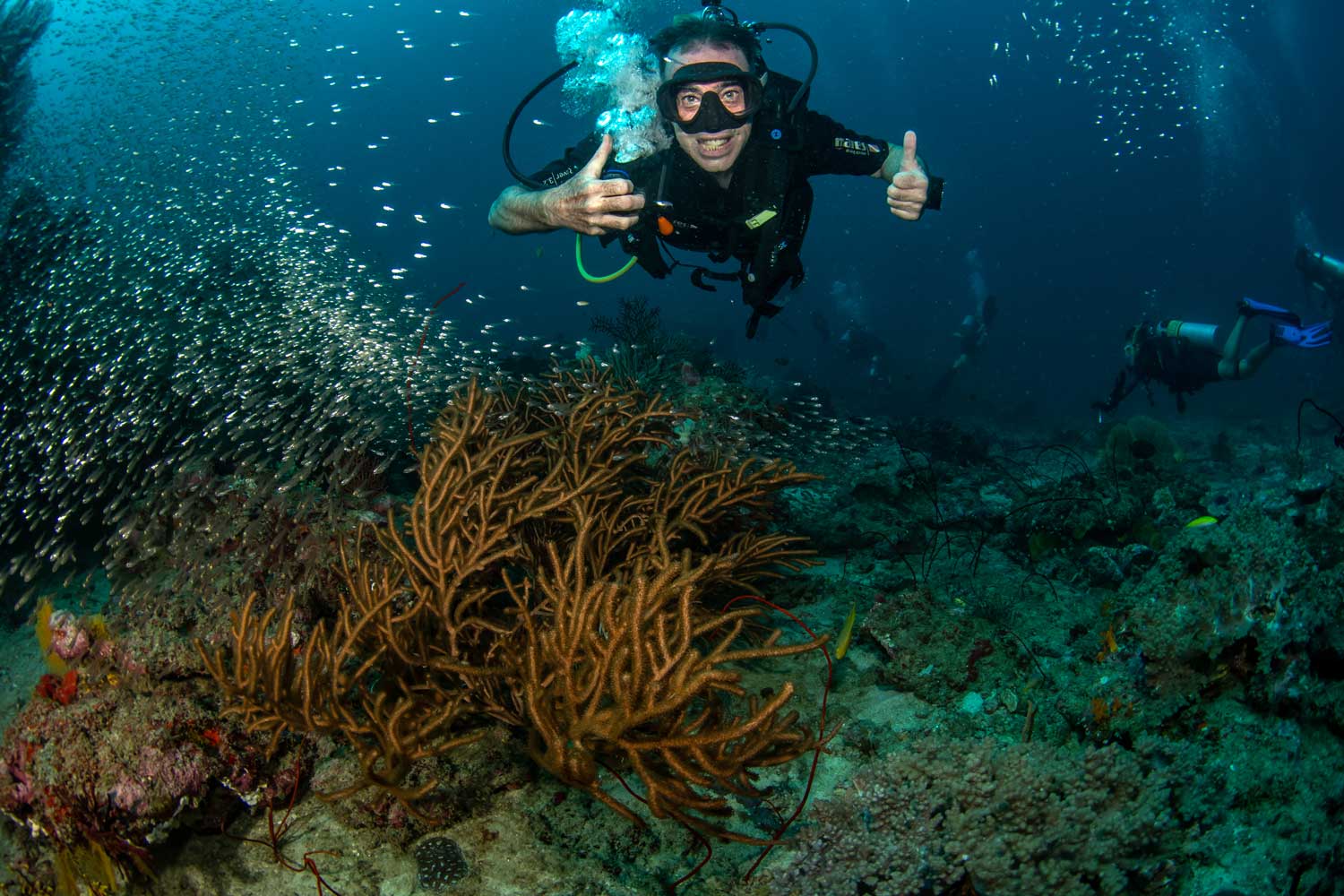
Two thumbs up
for this dive!

Longfin
batfish (Platax teira) can change color from silvery white with
no bands to
brown with darker banding, then fade back to silver again.
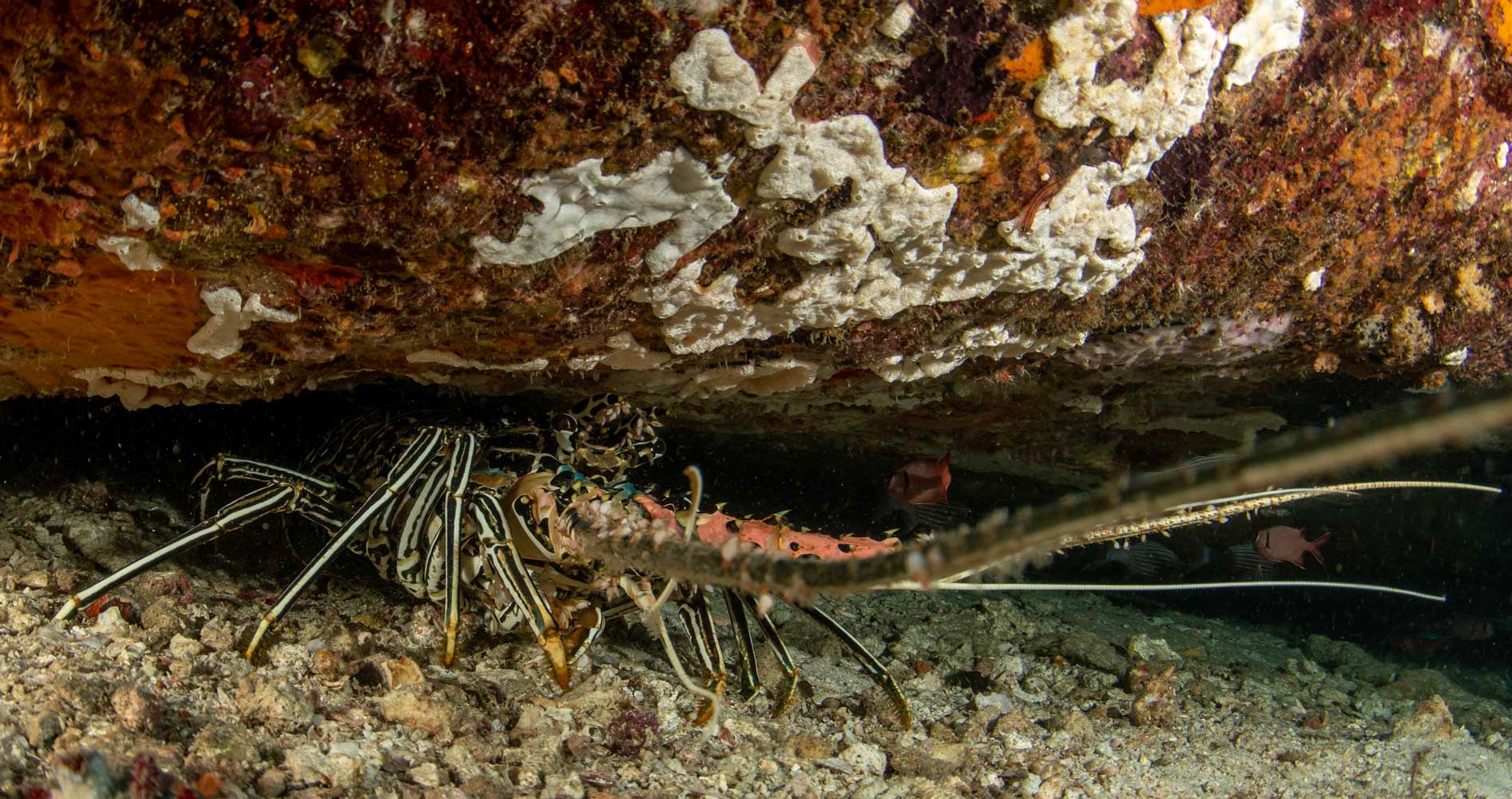
Lobsters like
to hide in cracks, but will venture out after dark.
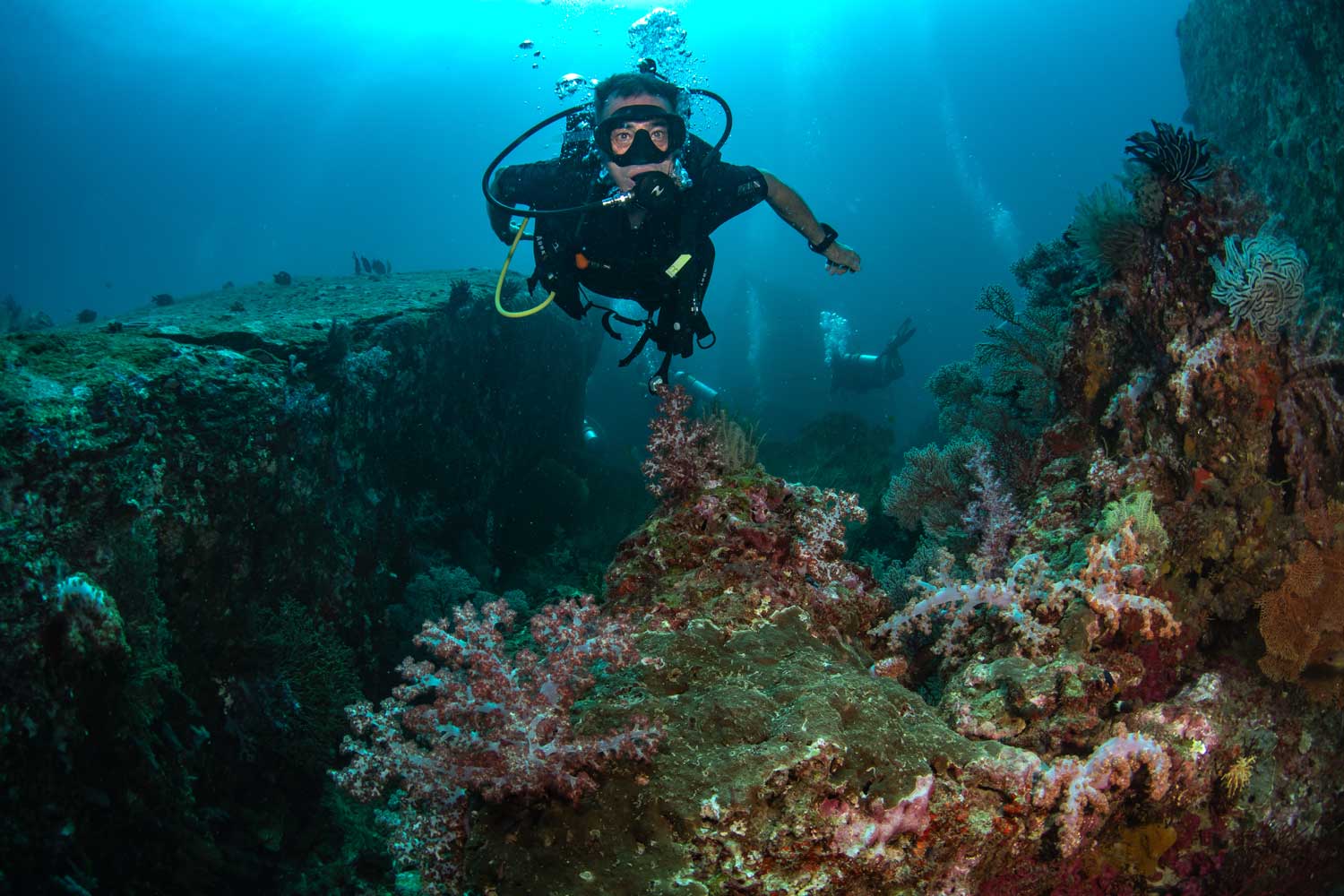
Pretty
scenery!
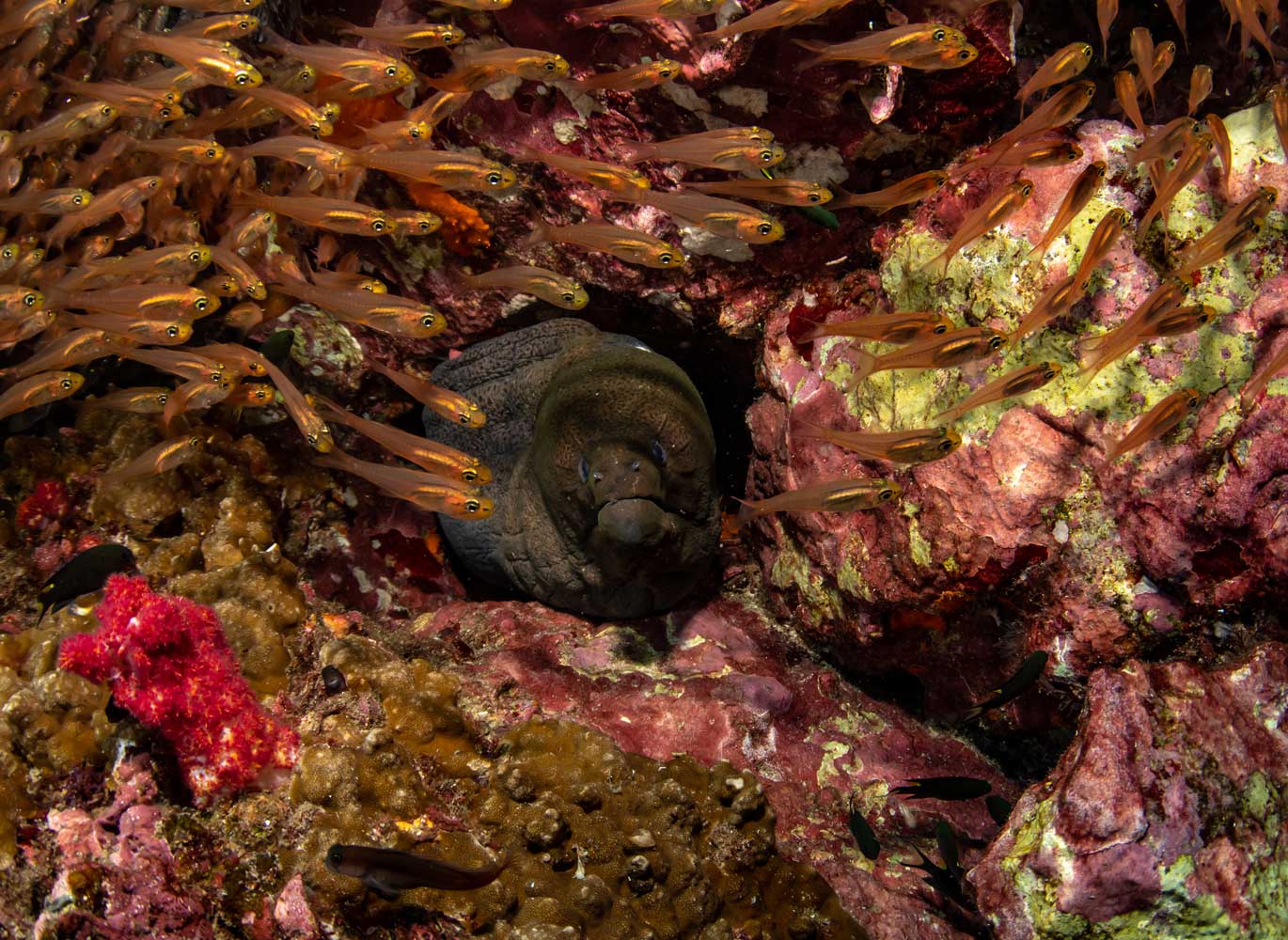
How do the little fish avoid become a meal for the giant moray eel?
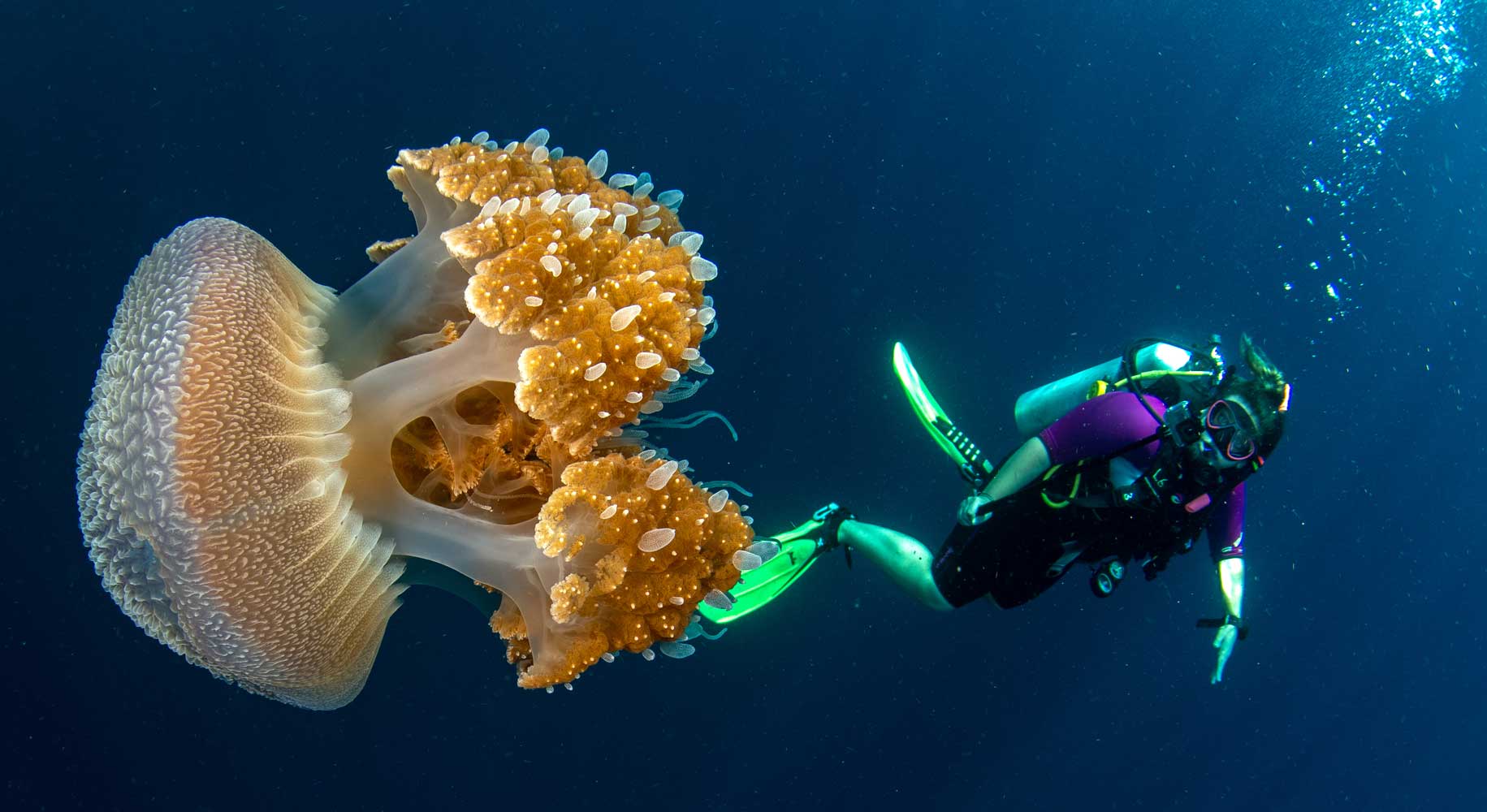
Jellyfish are
mesmerising to watch!
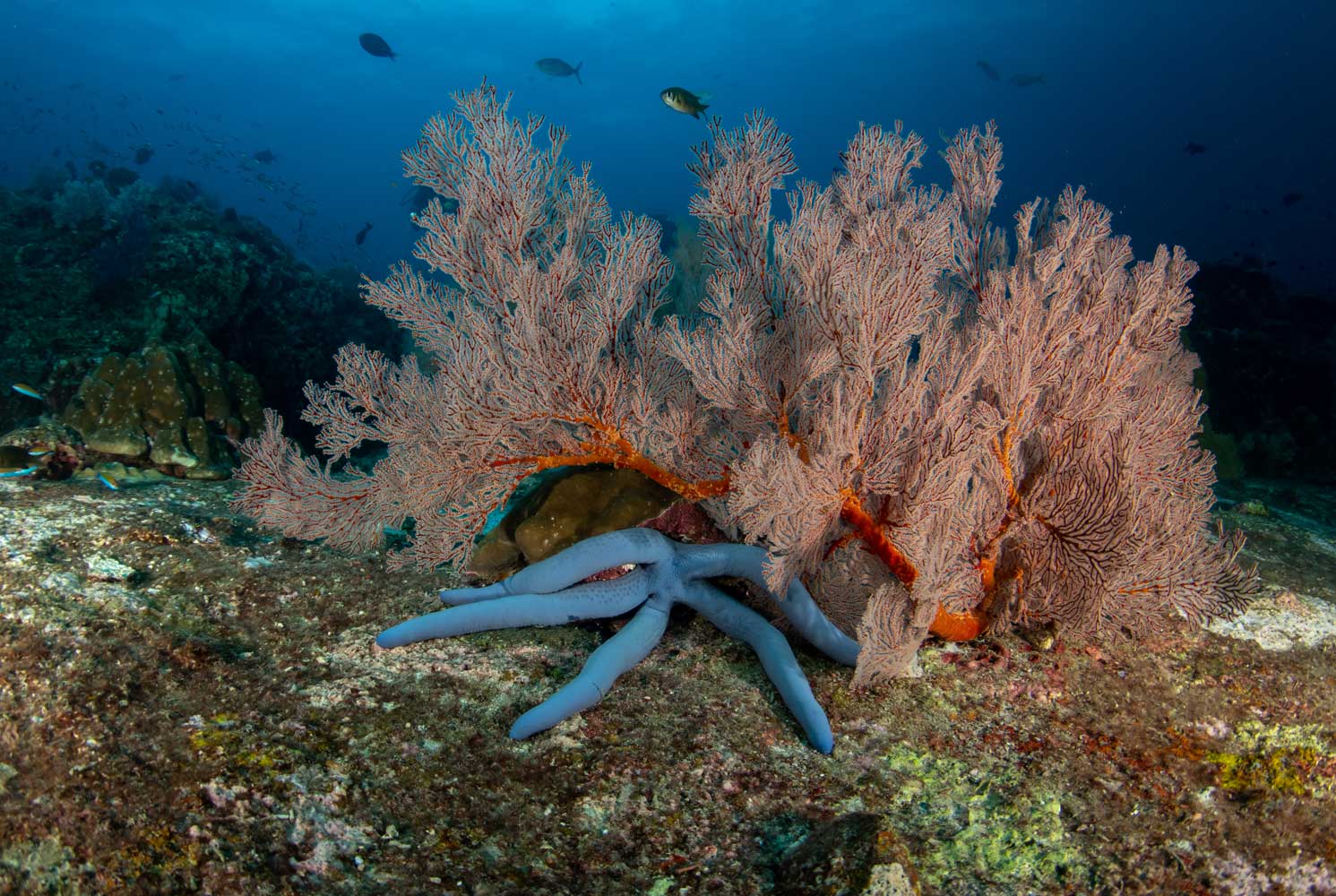
A starfish
snuggles in a coral garden.
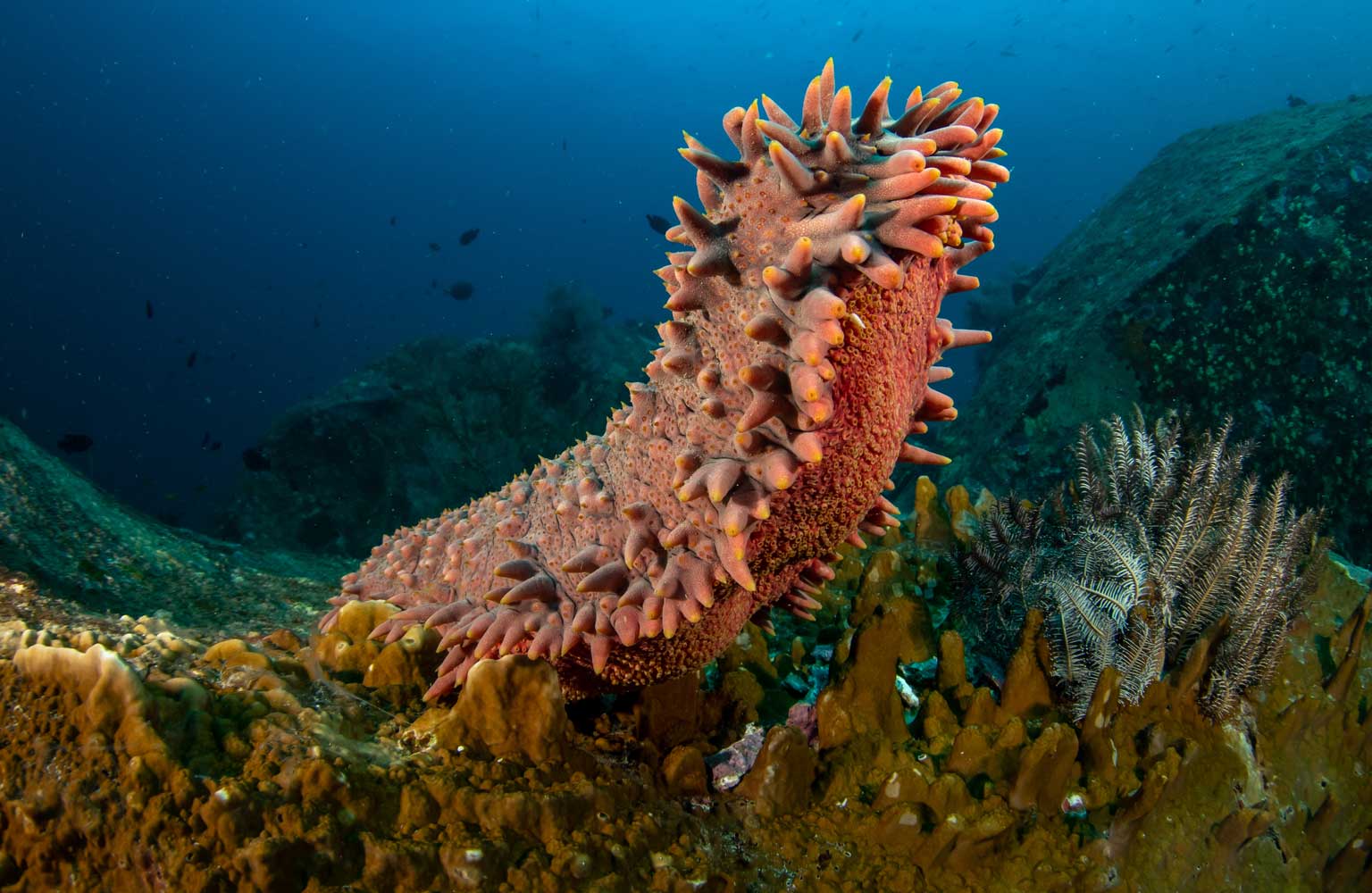
The pineapple
sea cucumber (Thelenota ananas) can reach up to
70 centimetres
(28 in) in length and is considered a delicacy in the East Asia.

Jenkinís whip
ray (Himantura jenkinsii)
1 December Andaman Sea
Many divers particularly enjoy seeking out the tiny
creatures of the sea, and thatís what we saw this morning when we went down
among the giant granite boulders at Koh Chi in the Surin Islands: banded boxer
shrimp, pipefish, pygmy pipehorse, flatworm, and the very well camouflaged
orangutan crab. The usual large fish swam about too.
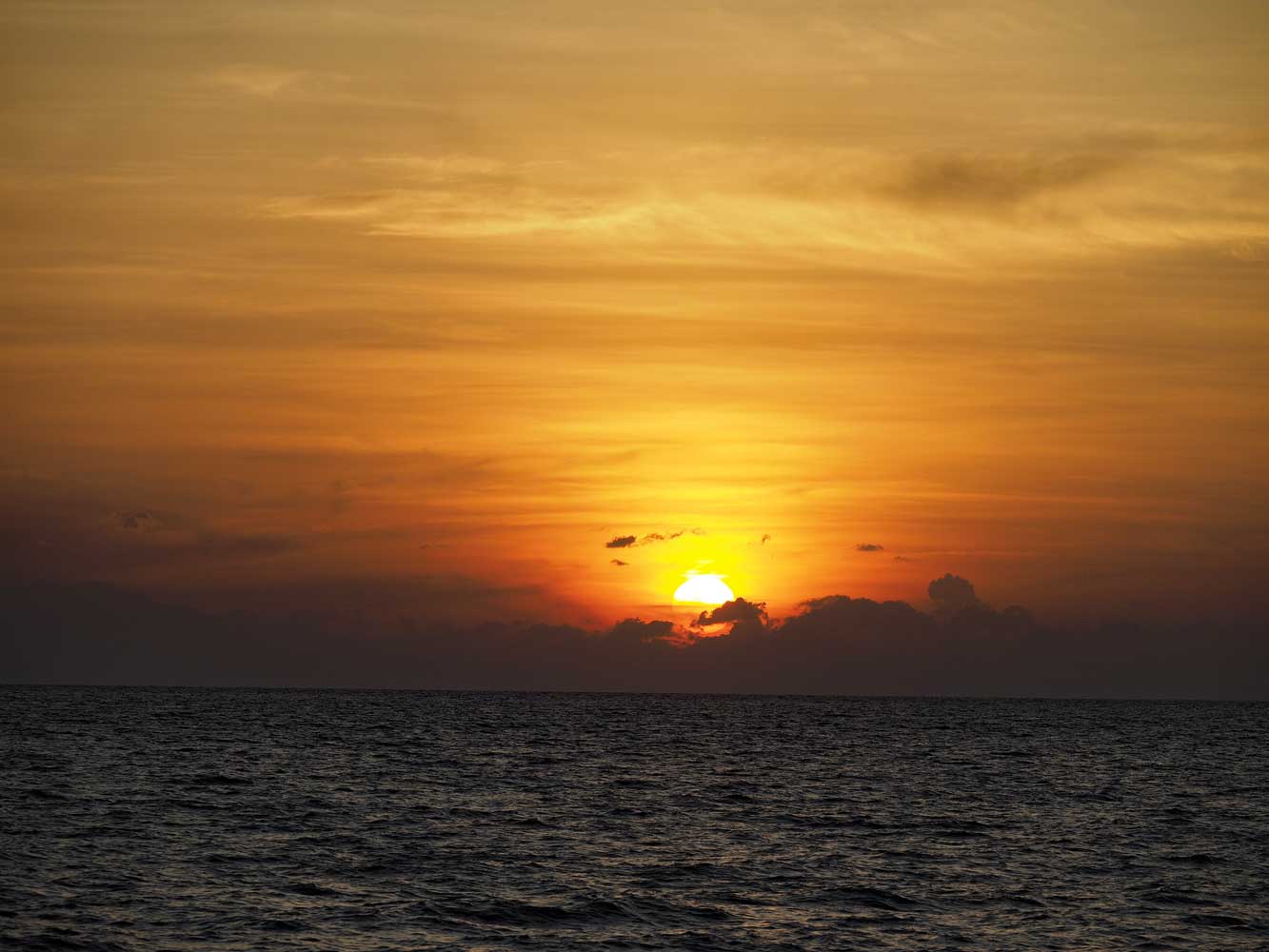
Sunrise over the Andaman Sea
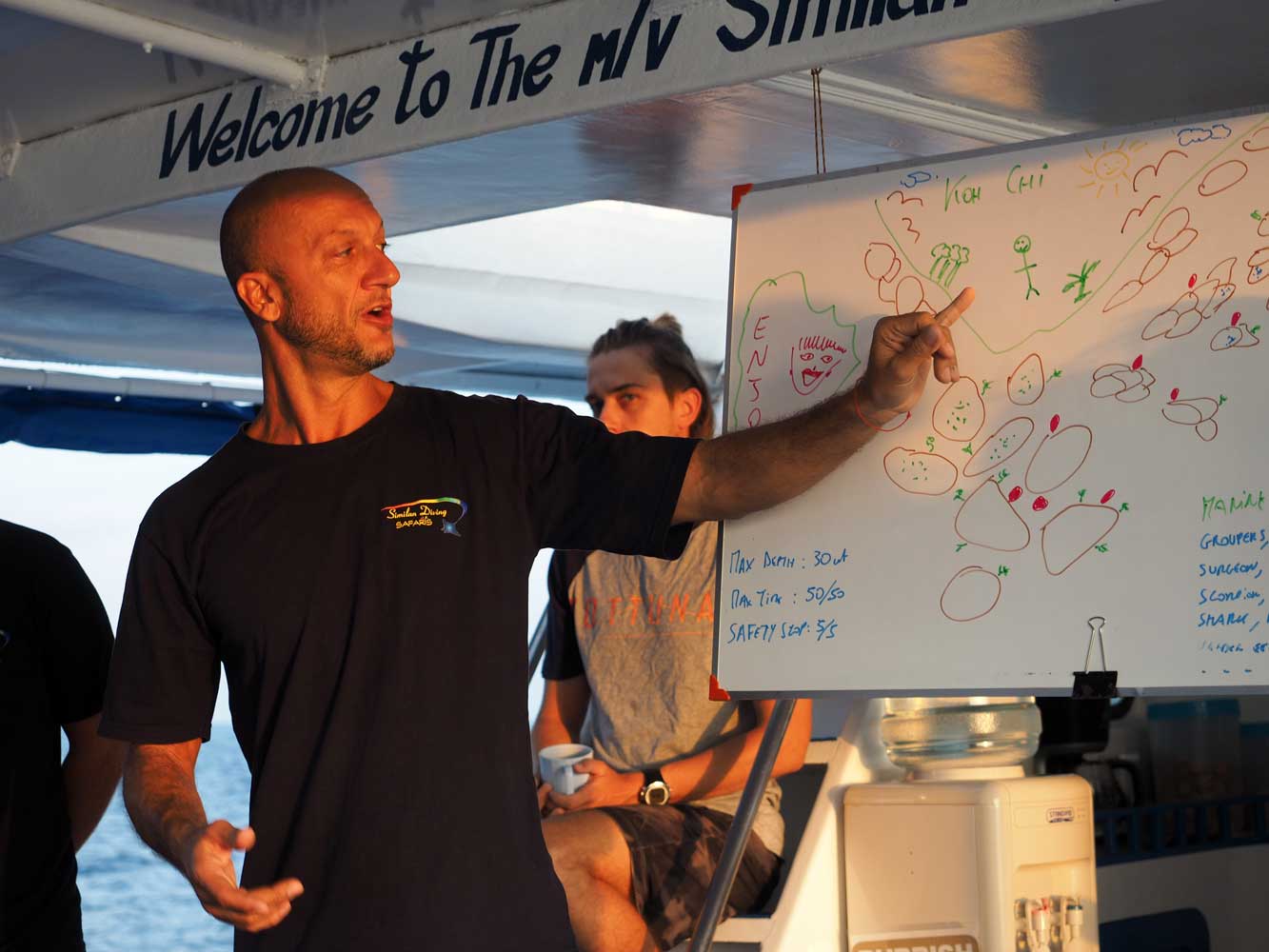
Luca tells us what
to expect at Koh Chi. We get an illustrated briefing like this before every
dive.
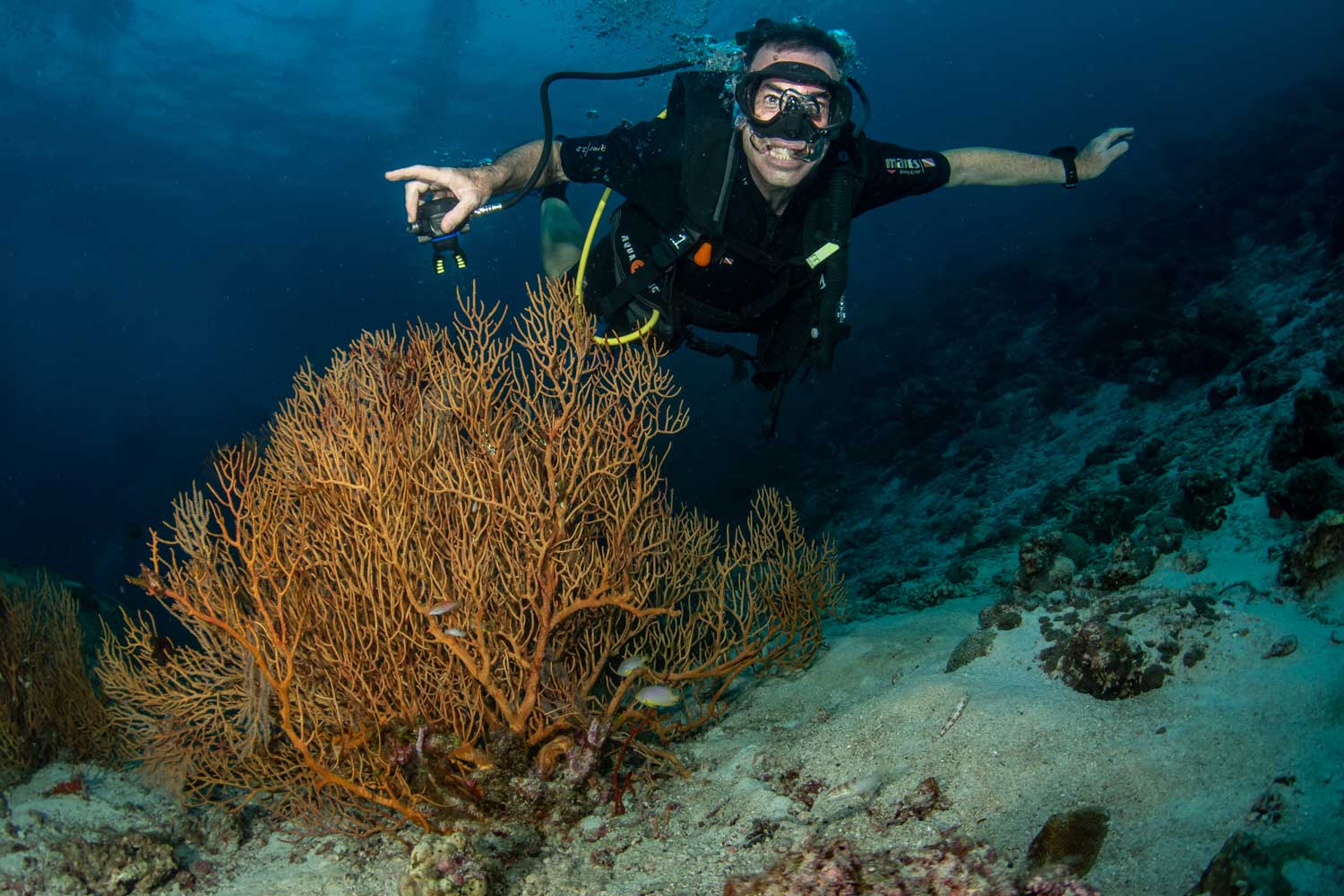
Yes, thatís a smile!
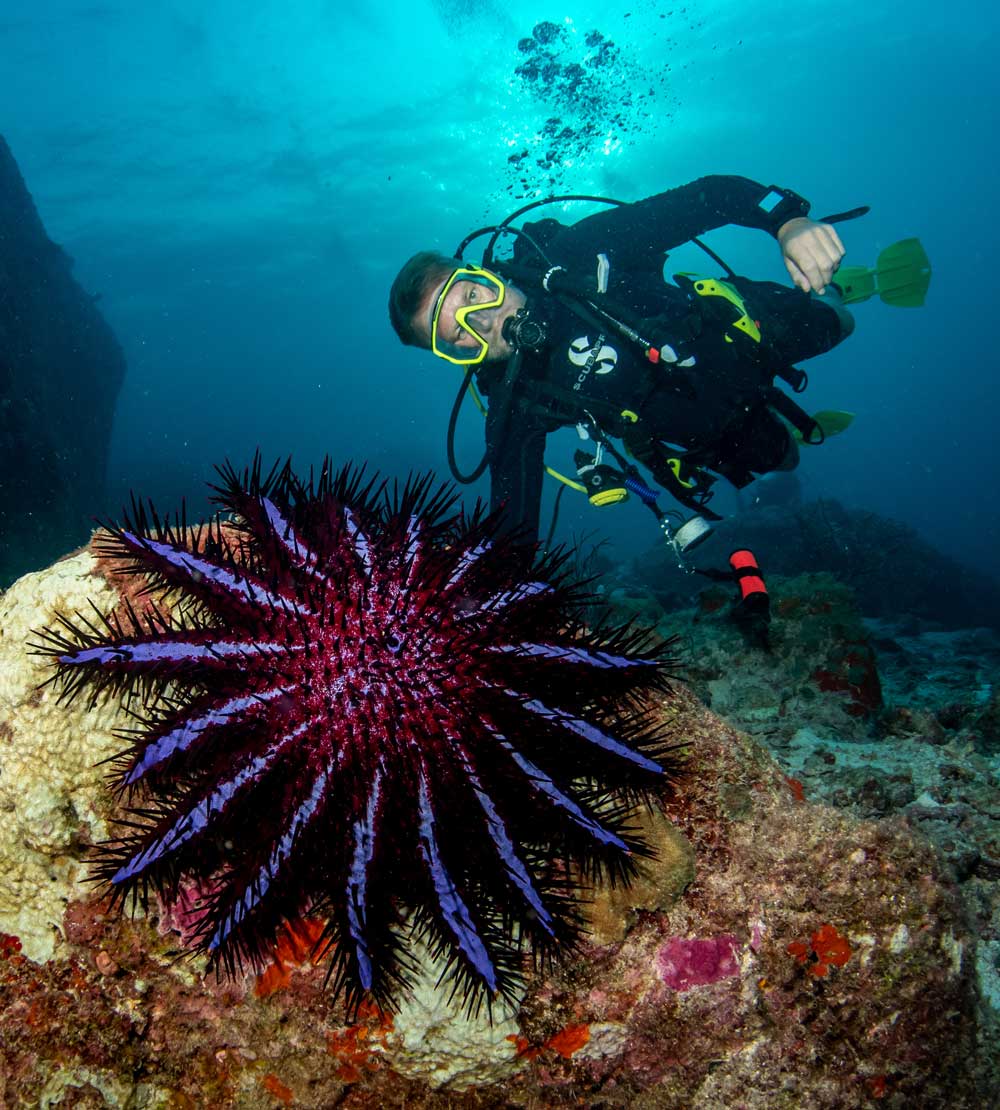
Nobody likes
the crown-of-thorns starfish (Acanthaster planci) because it chews up
hard coral polyps.
Venomous thorn-like spines cover its upper surface. Itís
one of the largest starfish in the world.
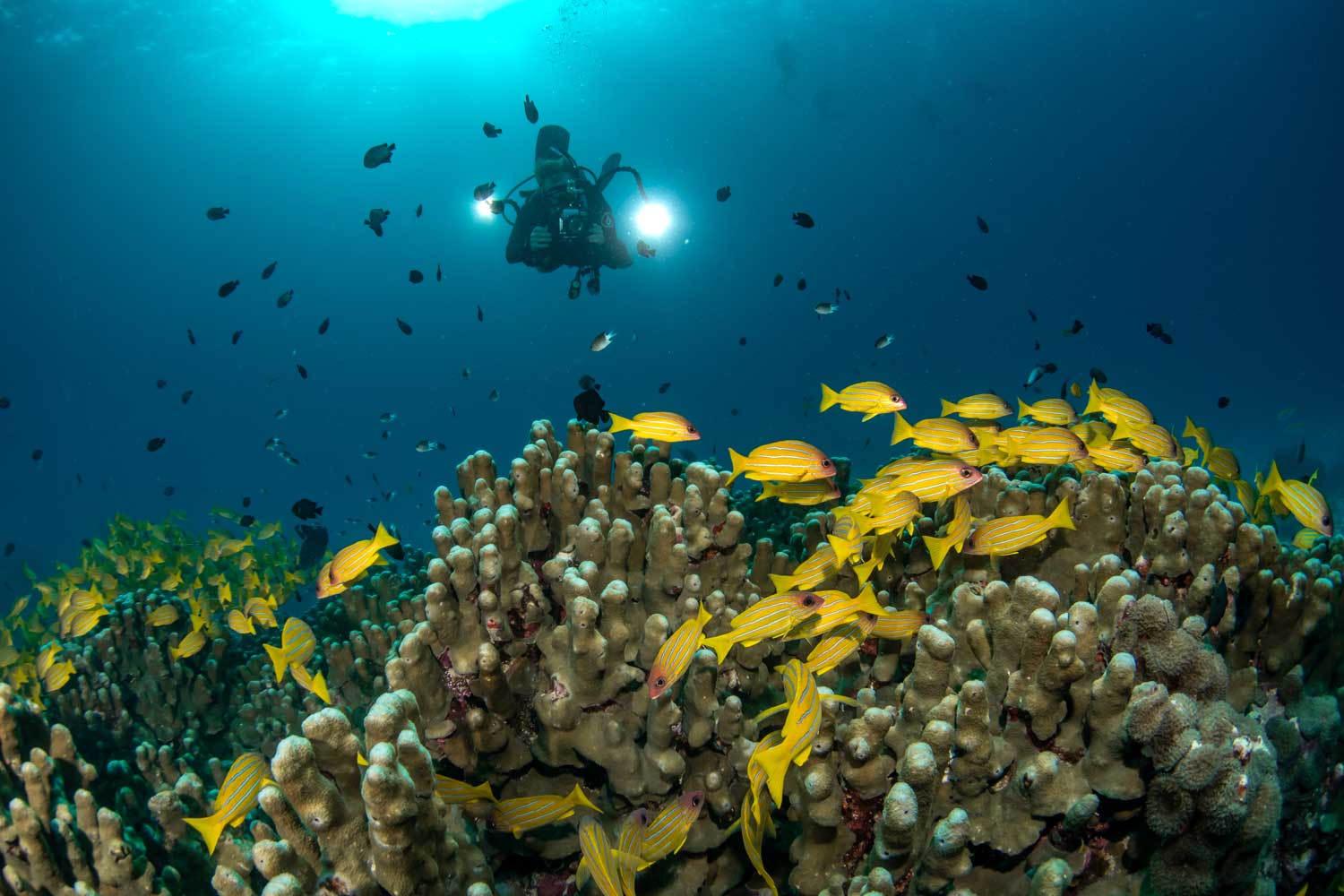
Photographer
meets photographer over a school of bluestripe snappers.
After breakfast we made a shore excursion to Morgan Village, inhabited by Moken (sea
gypsies), in
the Similan Islands. Their simple houses face the sea from which live, though
they also have gardens in the jungle behind. Nearly every house had a little
souvenir stand with wood carvings and other hand crafts, but otherwise villagers
took little notice of us. A Thai teacher was busy grading papers in the two-room
schoolhouse. Neither the Thai nor Myanmar governments recognize the Moken as
citizens unless a child is born on the mainland, which rarely happens, so most
villagers have no papers. I enjoyed stretching my legs by walking the length of
the beach.

A Moken villager shuttles us to shore.
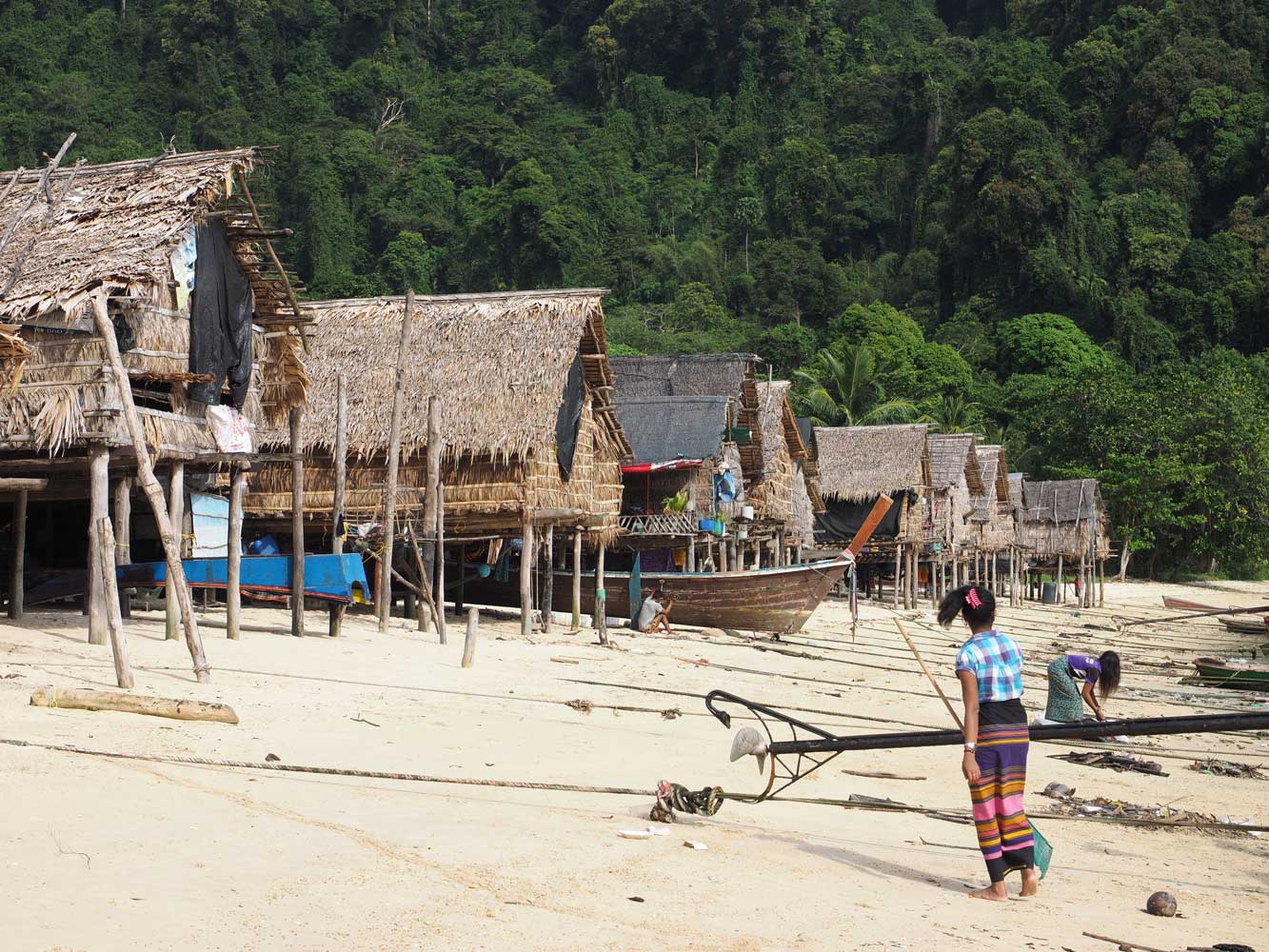
People live close
to the sea at Morgan village.
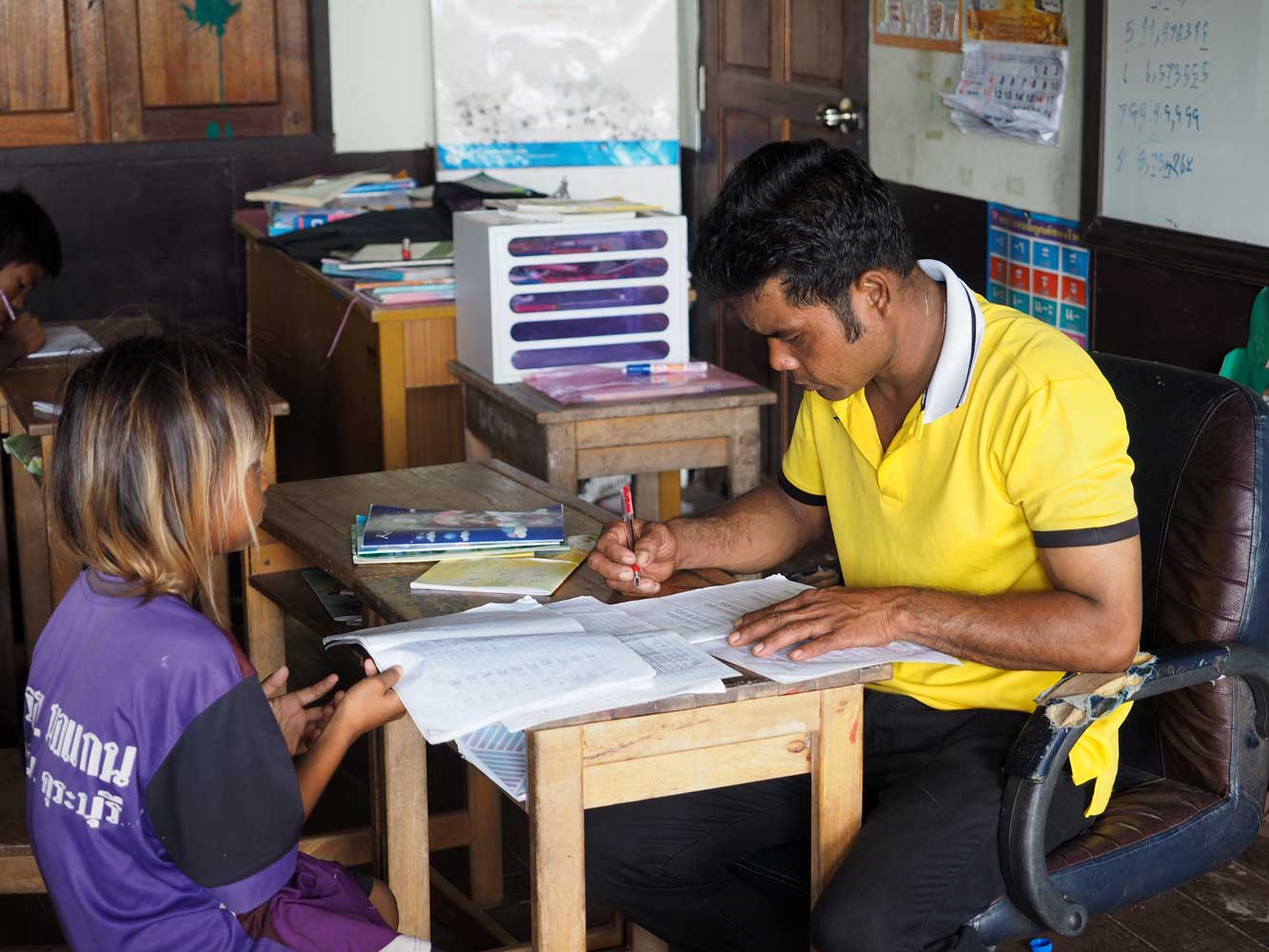
Checking papers at
school
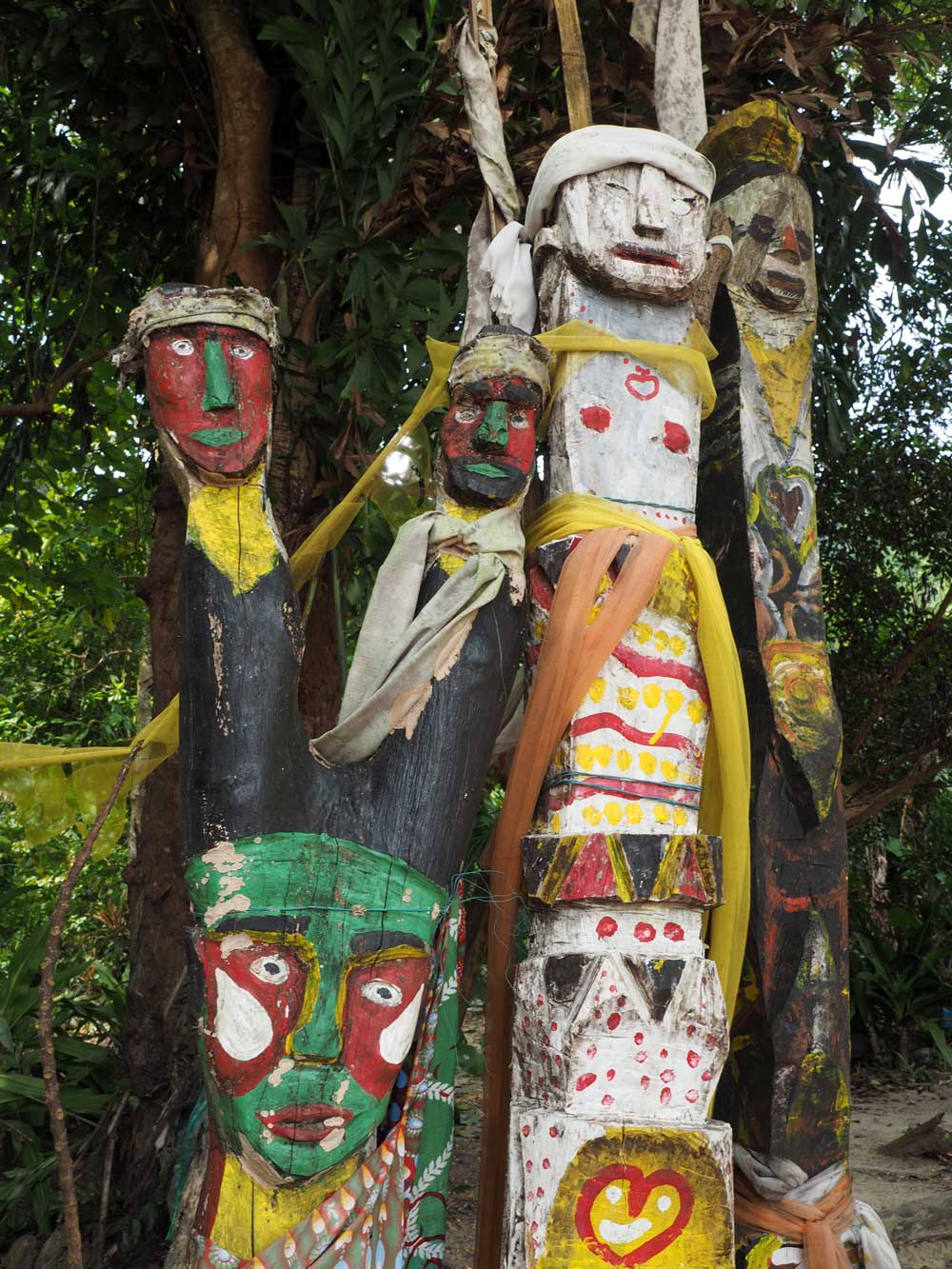
Spirit totems in the village
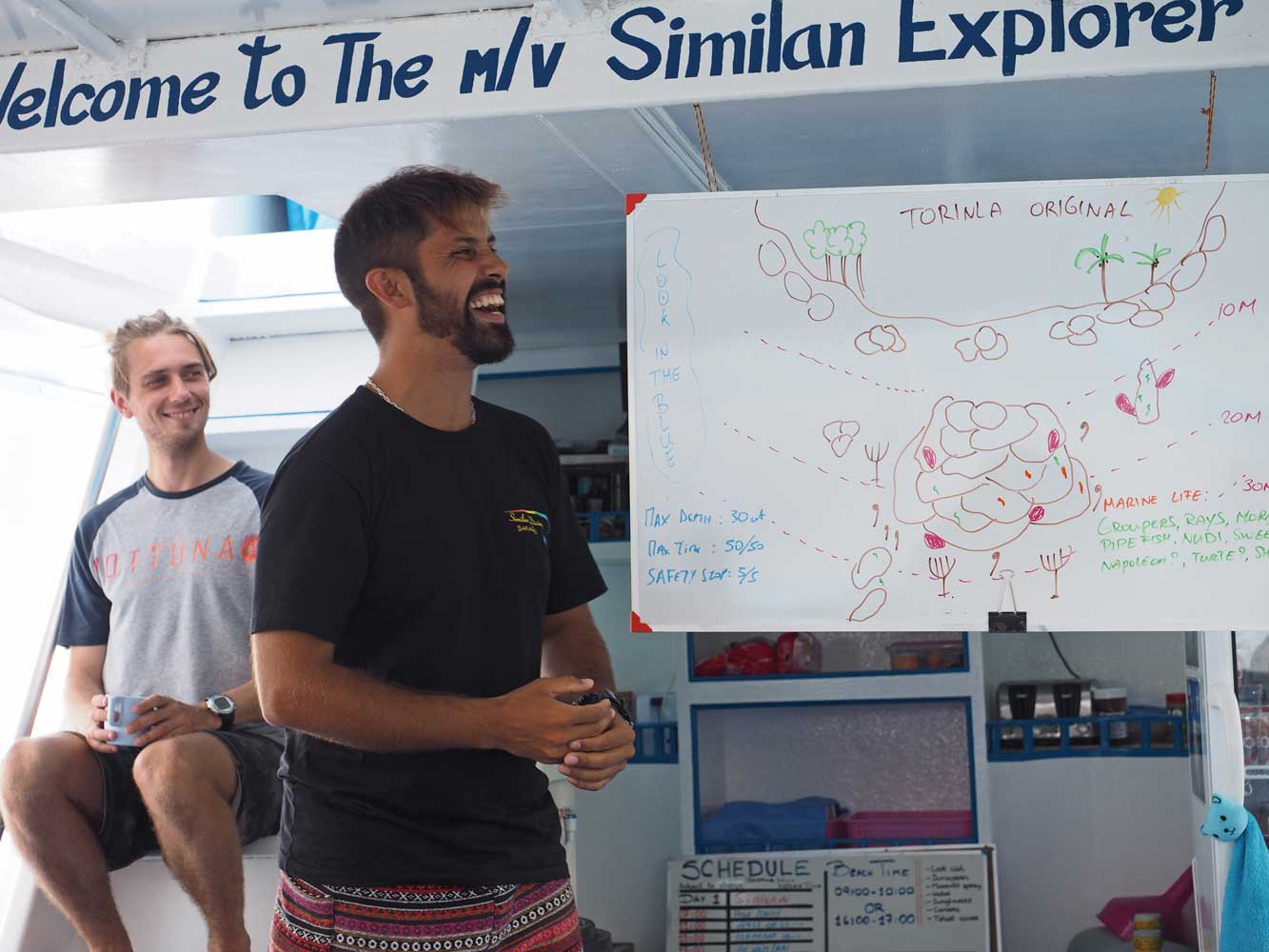
Pablo gives us the
briefing, with a joke or two, for the late morning dive. Photographer
Krzysztof Bargiel looks on.
At Torinla Original in the Similans, we explored the great pile of granite
boulders surrounded by sand and found the difficult-to-see ghost pipefish. We
had an enthusiastic photographer, Kim from Hong Kong, in our group and he got
nipped on the leg when he moved in too close to a nesting triggerfish. Kim was
lucky, as our dive leaders later regaled us with tales of how divers had to have
as many as ten stitches in their head after triggerfish encounters!

A giant
moray eel (Gymnothorax javanicus) patiently waits for something tasty
to swim by at Torinla Original.
The afternoon excursion went to nearby Torinla North, where a strong current
made for a drift dive. Good growths of hard coral clung to boulders, but a lot
of the dive went over an ugly expanse of coral rubble. We saw a Jenkinís ray,
two moray eels, lots of pufferfish, groupers, triggerfish, and a hawksbill
turtle.
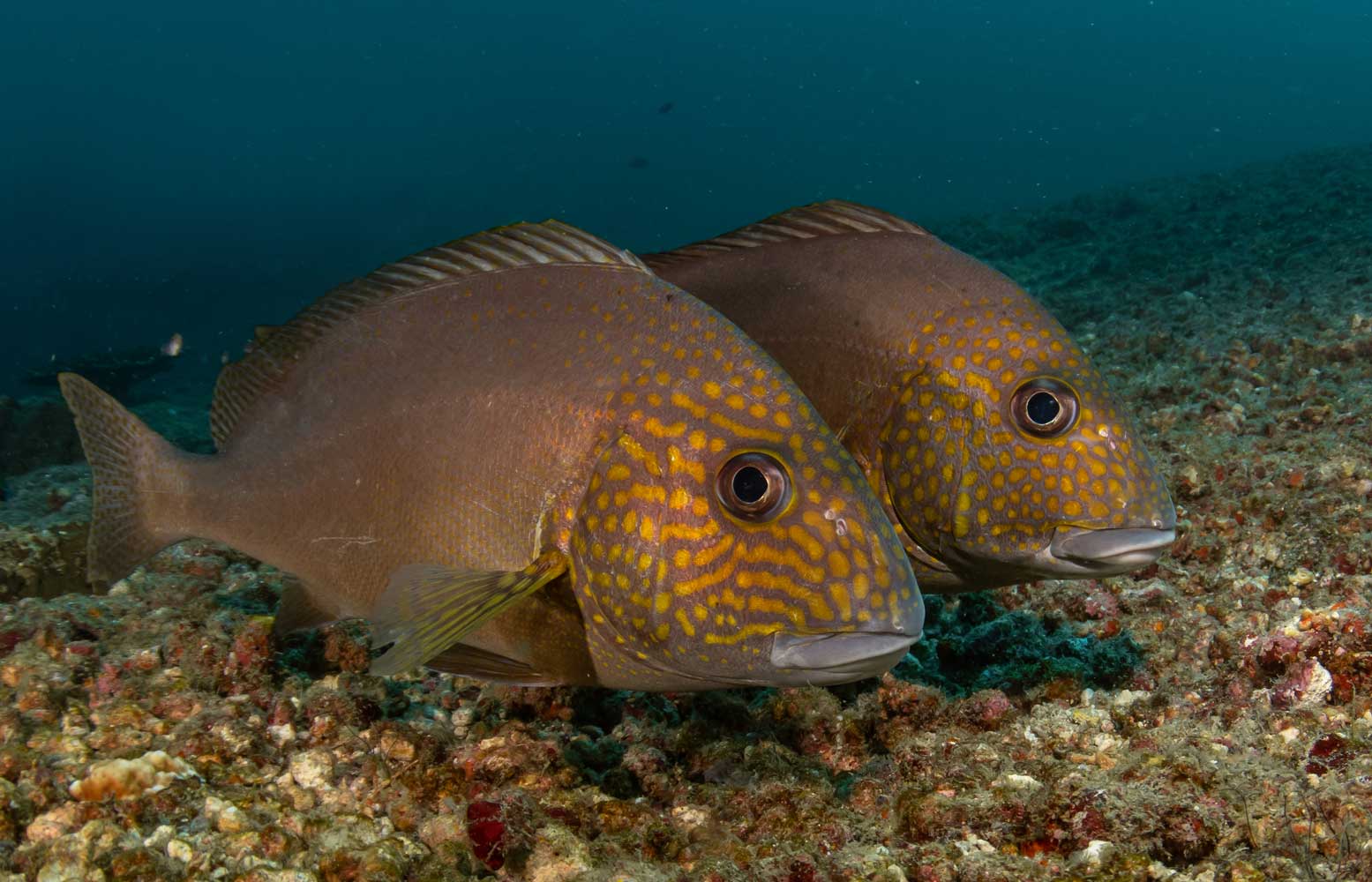
I think
these are painted sweetlips (diagramma pictum). They look like a happy
couple!
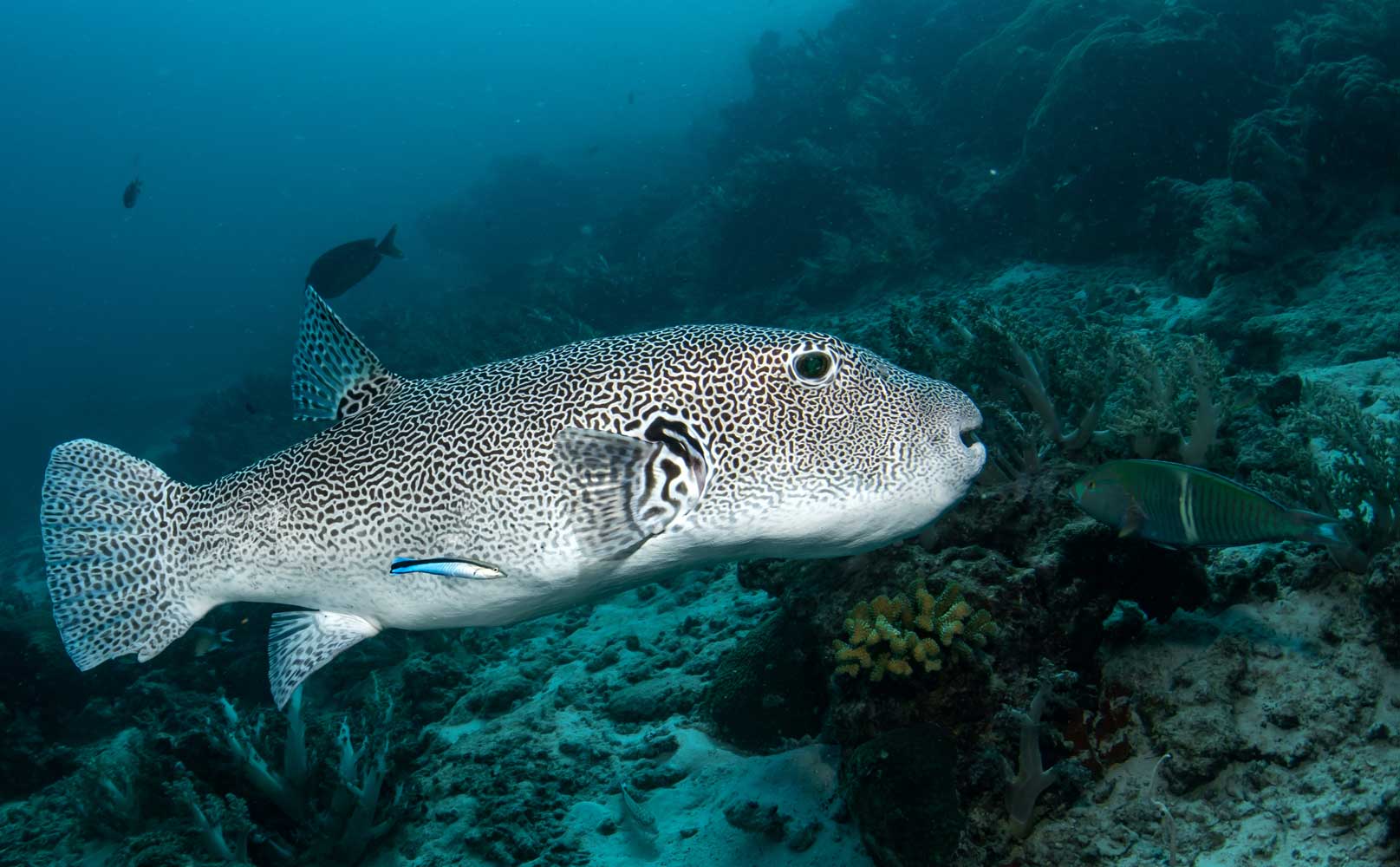
starry puffer (Arothron stellatus)

Back topside on the
bow, Luca gets a rare chance to relax!
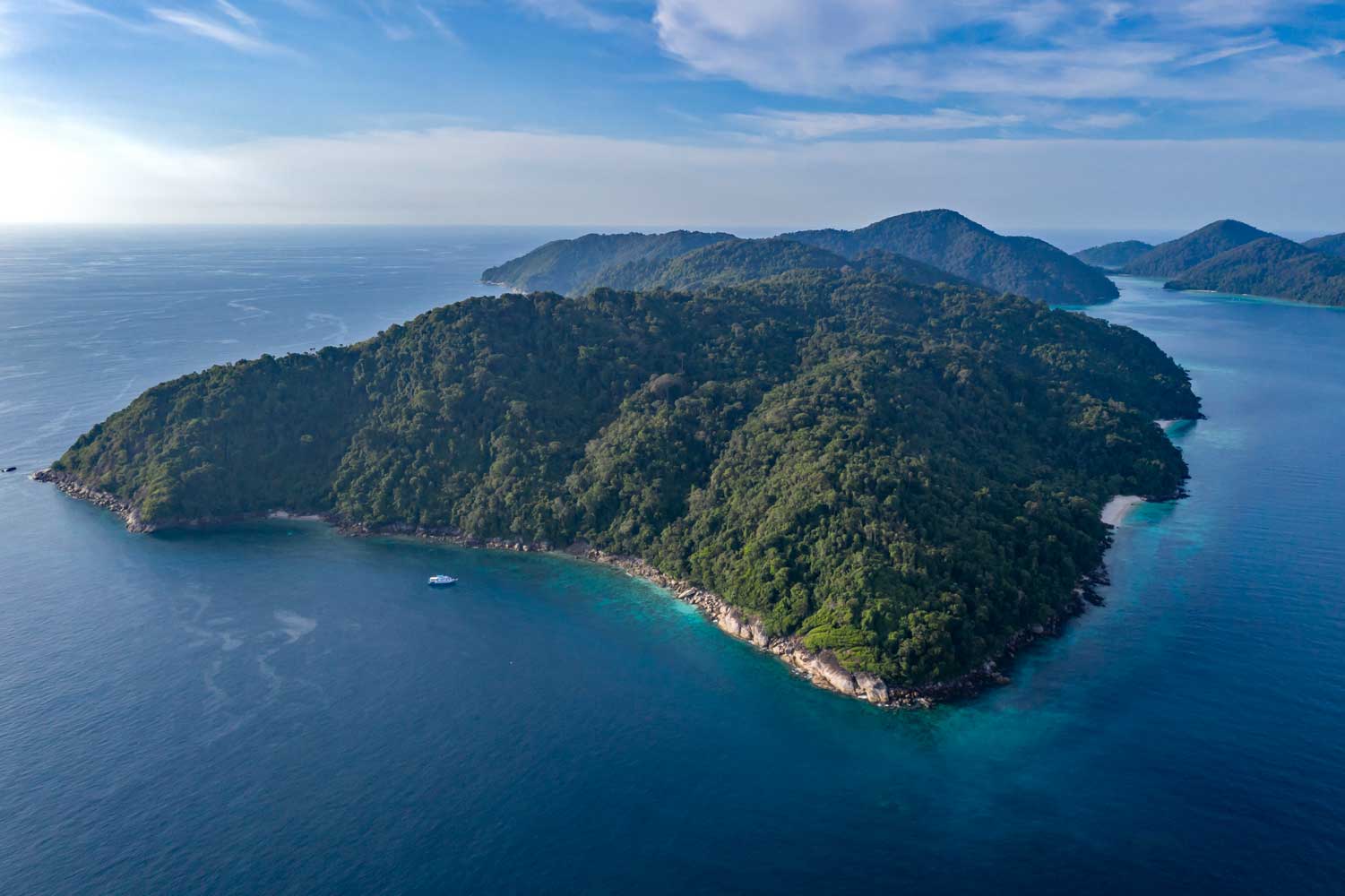
Surin Islands
Our sunset dive visited Richelieu Rock, the most famous dive site in the
region for its abundance of colorful soft corals and huge numbers of fish. Itís
a croissant-shaped undersea pinnacle whose summit just breaks the surface at low
tide. Unfortunately the water was on the murky side with visibility only about 6
meters, plus my mask was fogging badly. Three cuttlefish made an appearance
early in the dive. Many silvery and slim crocodile needlefish hung out near the
surface.
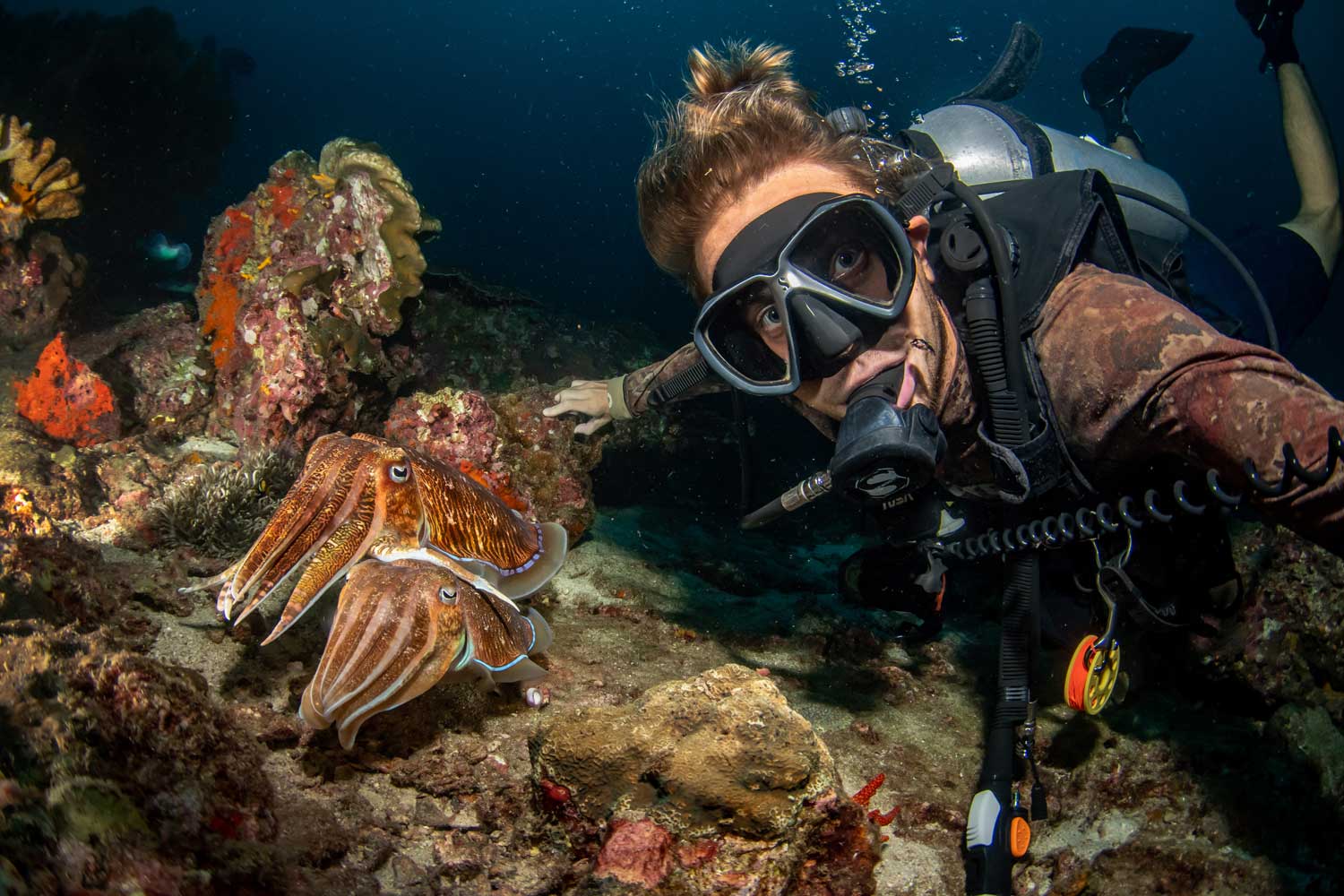
Krzysztof
Bargiel makes a selfie with amorous cuttlefish at Richelieu Rock.
Cuttlefish
come in more than 120 species in 5 genera. The creature has amazing visual,
communications, and camouflage skills; more at
https://en.wikipedia.org/wiki/Cuttlefish.
2 Dec. Khao Lak
The sea was still murky at Richelieu Rock in the
morning, though visibility had improved. We came across a pair of cuttlefish
early in the dive, then a coupled pair near the end. Clouds of tiny glass fish
swarmed over the deep purple and red soft corals. ĎThe gangí of trevally,
napoleon wrasse, and rainbow runner swam together while on the hunt.

Some of the
beautiful soft corals that Richelieu Rock is so famous for.

Iím shocked at
the unabashed love-making by the cuttlefish. Shocked!
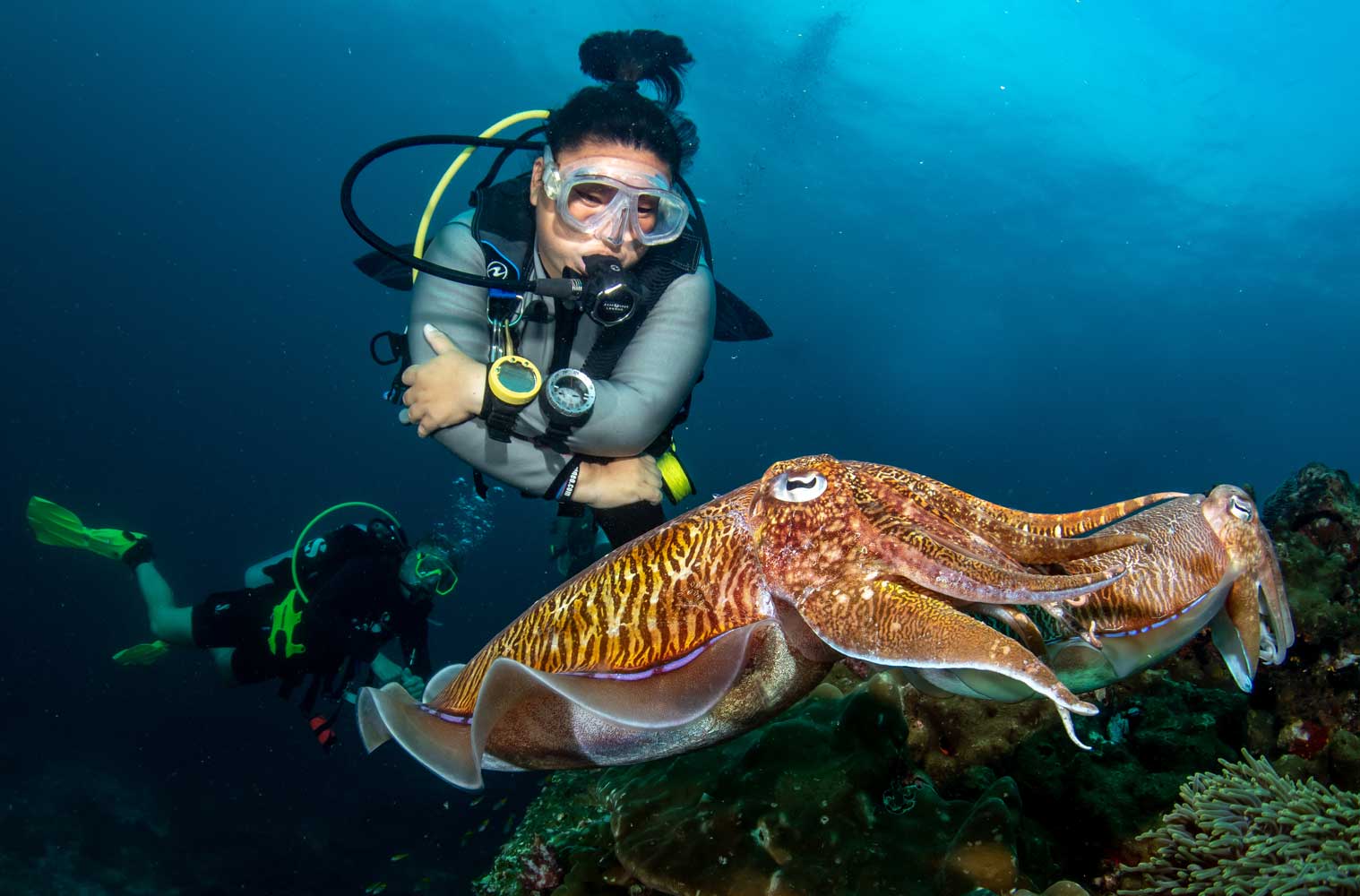
Soon-ie thinks
the cuttlefish are cute!
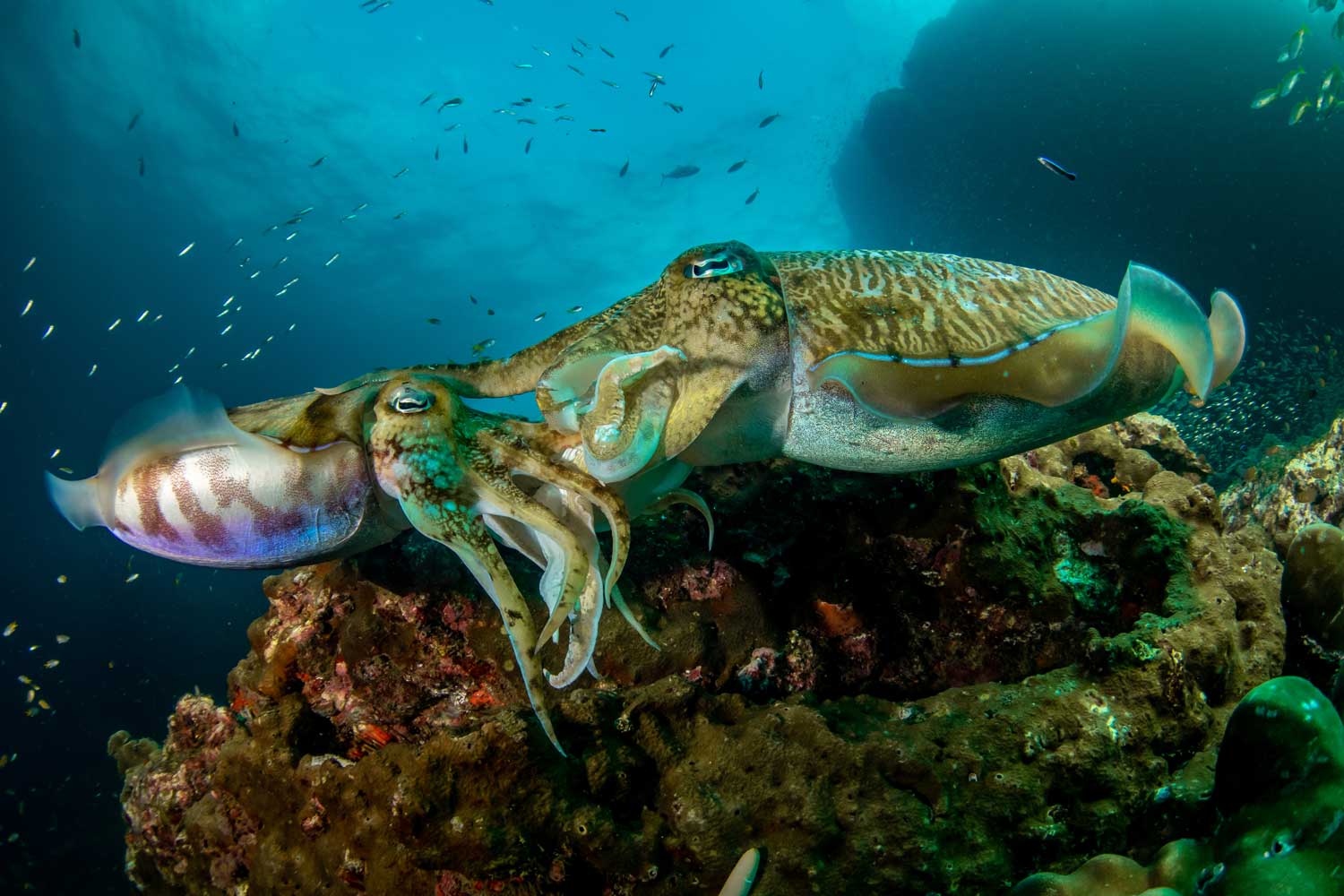
And not a bit
camera shy!
The final dive of the trip also went down at Richelieu Rock, and visibility
had improved a bit. Again we saw cuttlefish, including a male embracing a female
with a Ďspareí female hanging out nearby. They are remarkably unafraid of divers
and a pair swam by very close to me. Underwater delights included sighting a
peacock manti shrimp, fimbriated and white-eye moray eels, a ribbon eel, and
lots of lionfish. A school of pickhandle barracuda passed by near the end of the
dive.

Glass fish
form a cloud over this little coral-covered pinnacle on our last dive at
Richelieu Rock.

I shared a little cabin with Kim and two other divers.

But we spent most
of the day topside on the large covered deck.
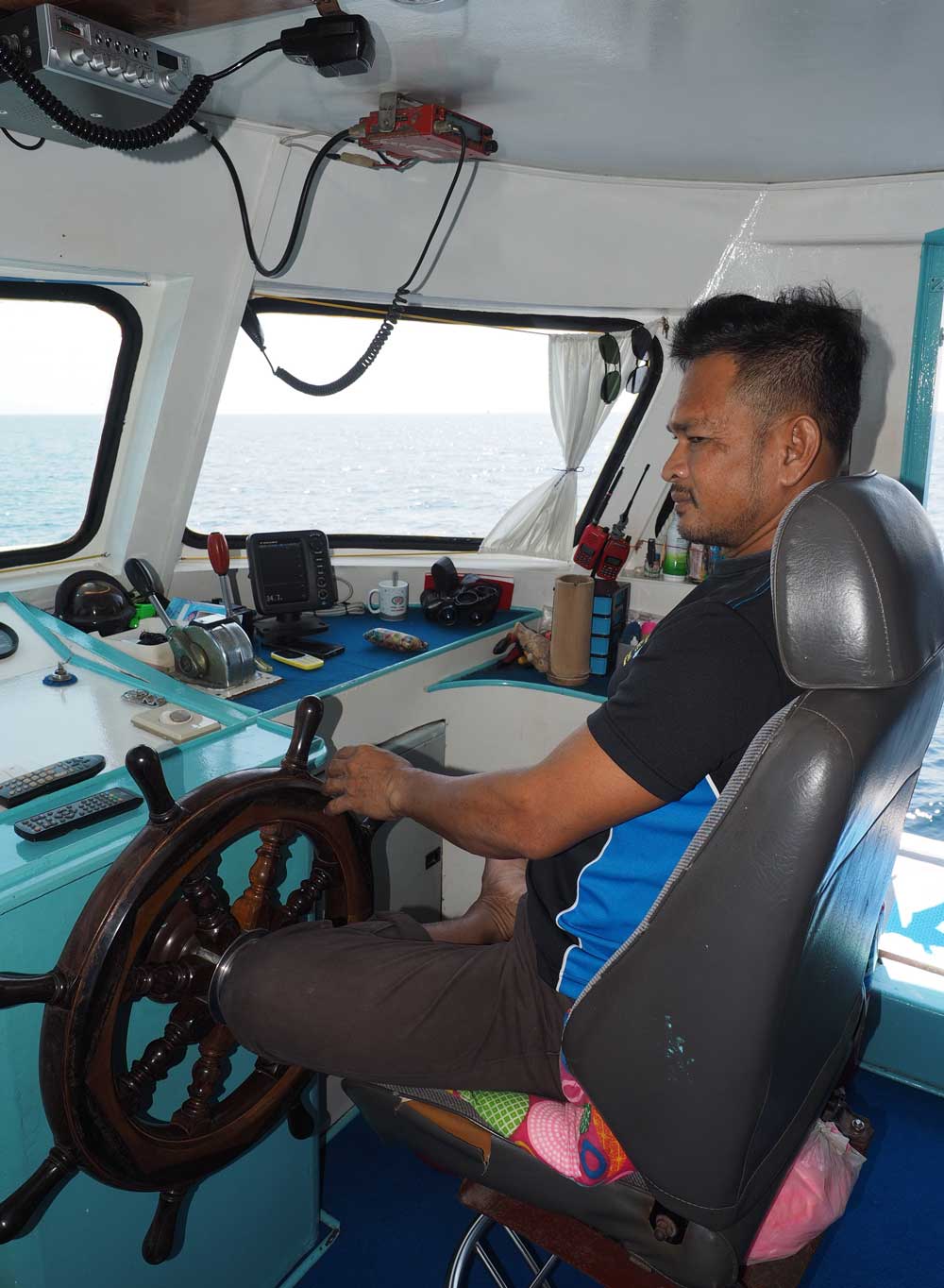
Our captain, Num,
safely navigated us to each dive site, then picked us up after each dive.
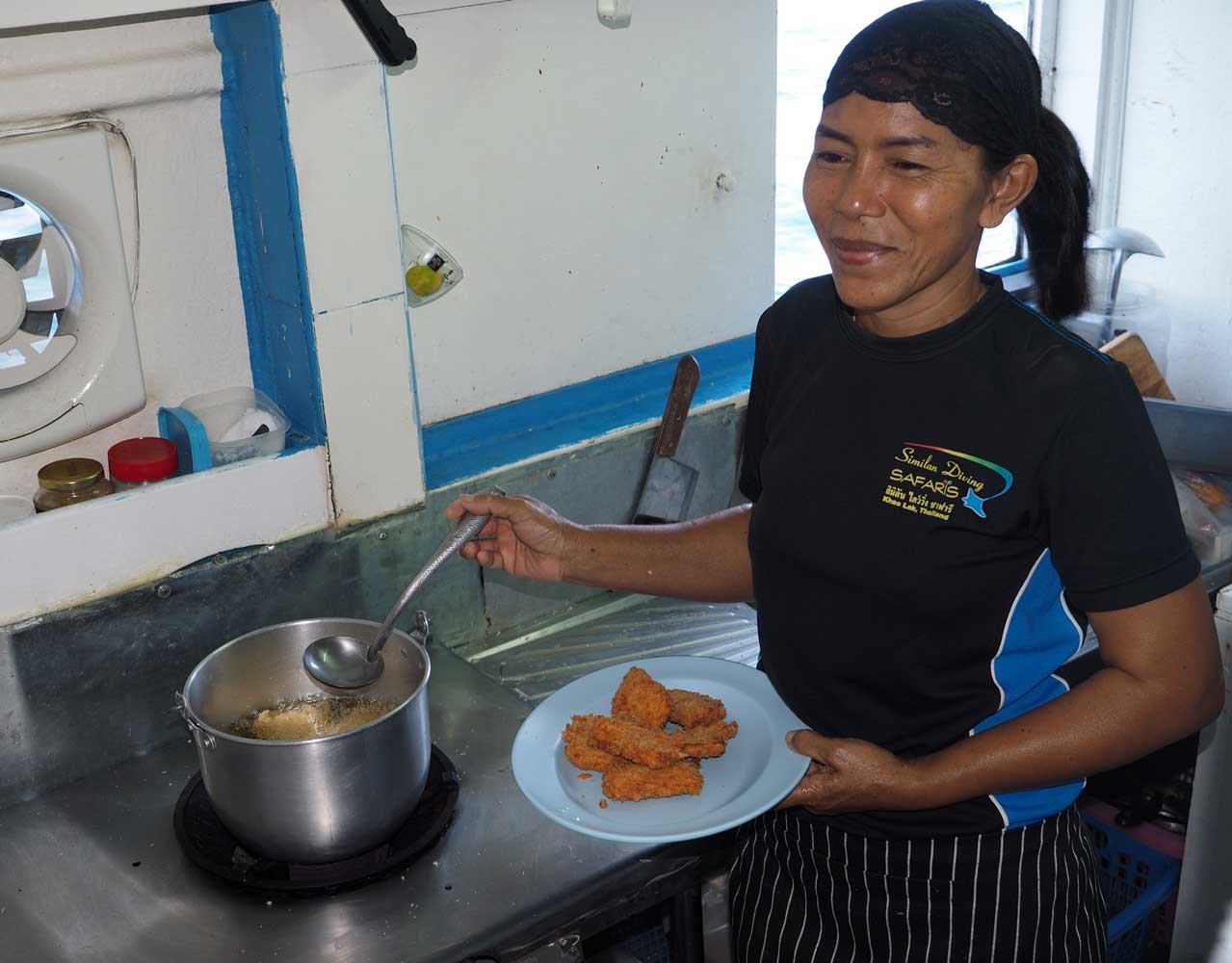
Our chef, Ten,
gave us very tasty meals.
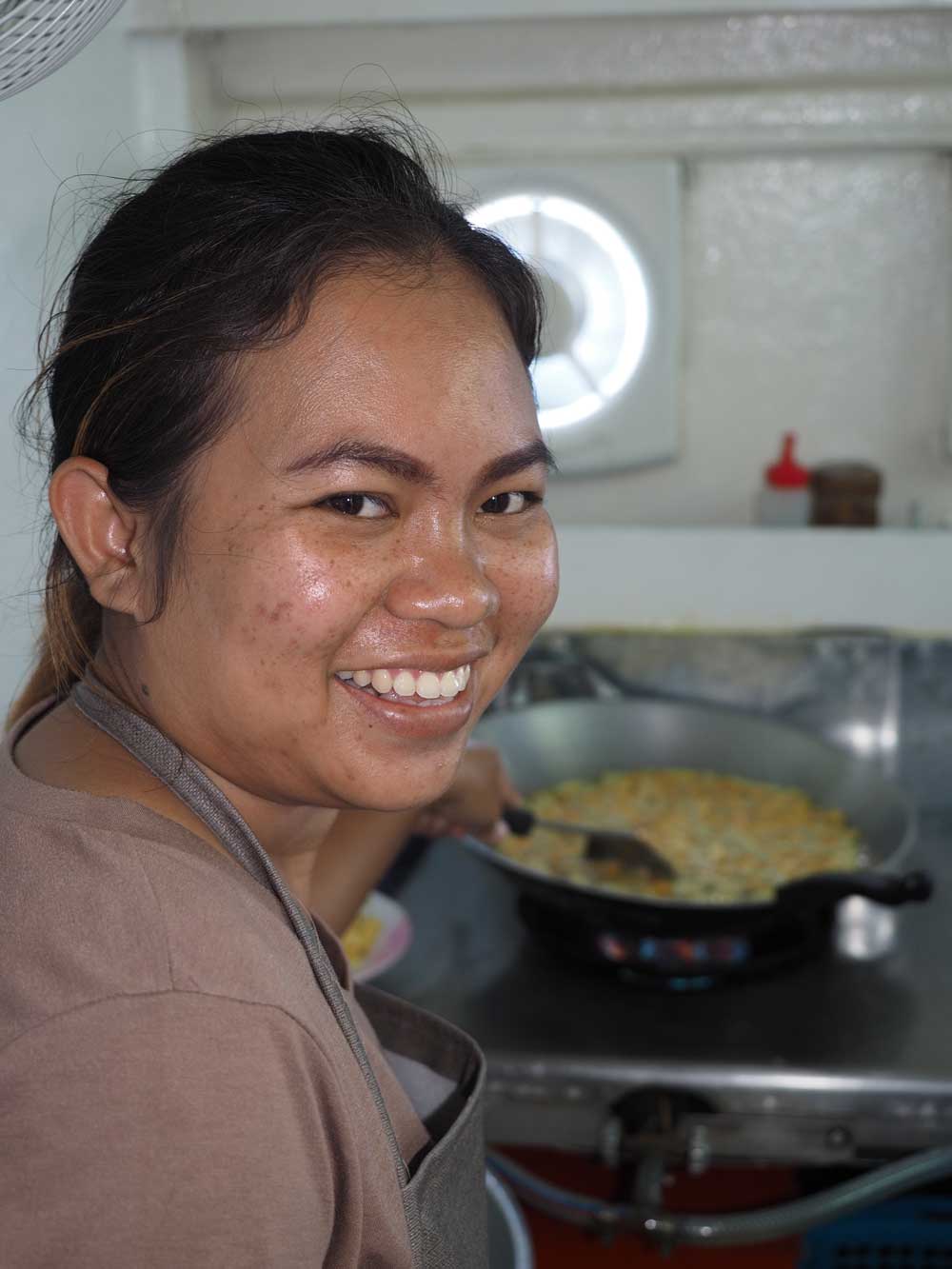
Sous-chef, Tan,
helped out in the little kitchen.

Tan readies our
Italian lunch as we motor to port.

We dig in!

And lastly, the
dishes.
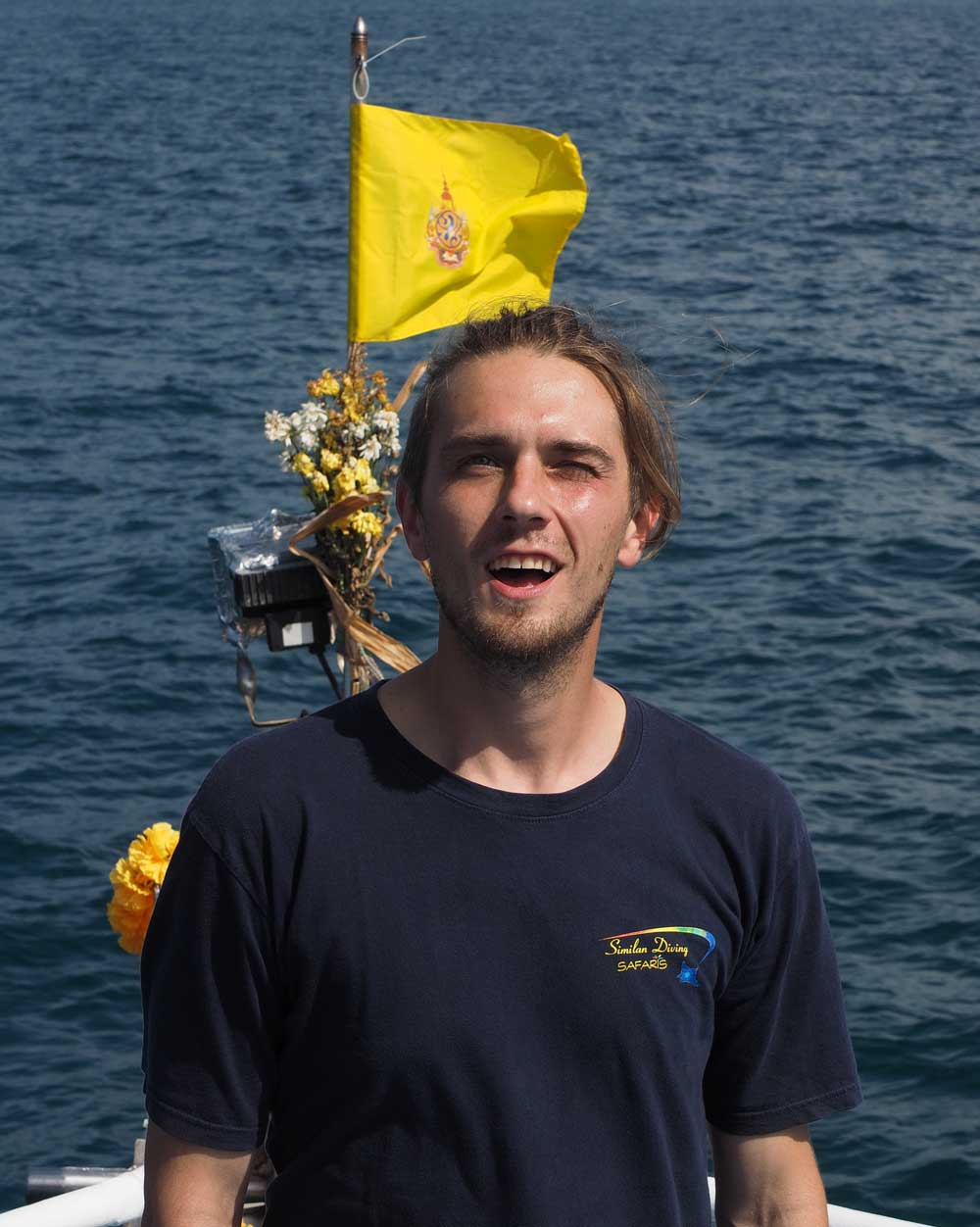
Krys
gets us organized for the group photo.
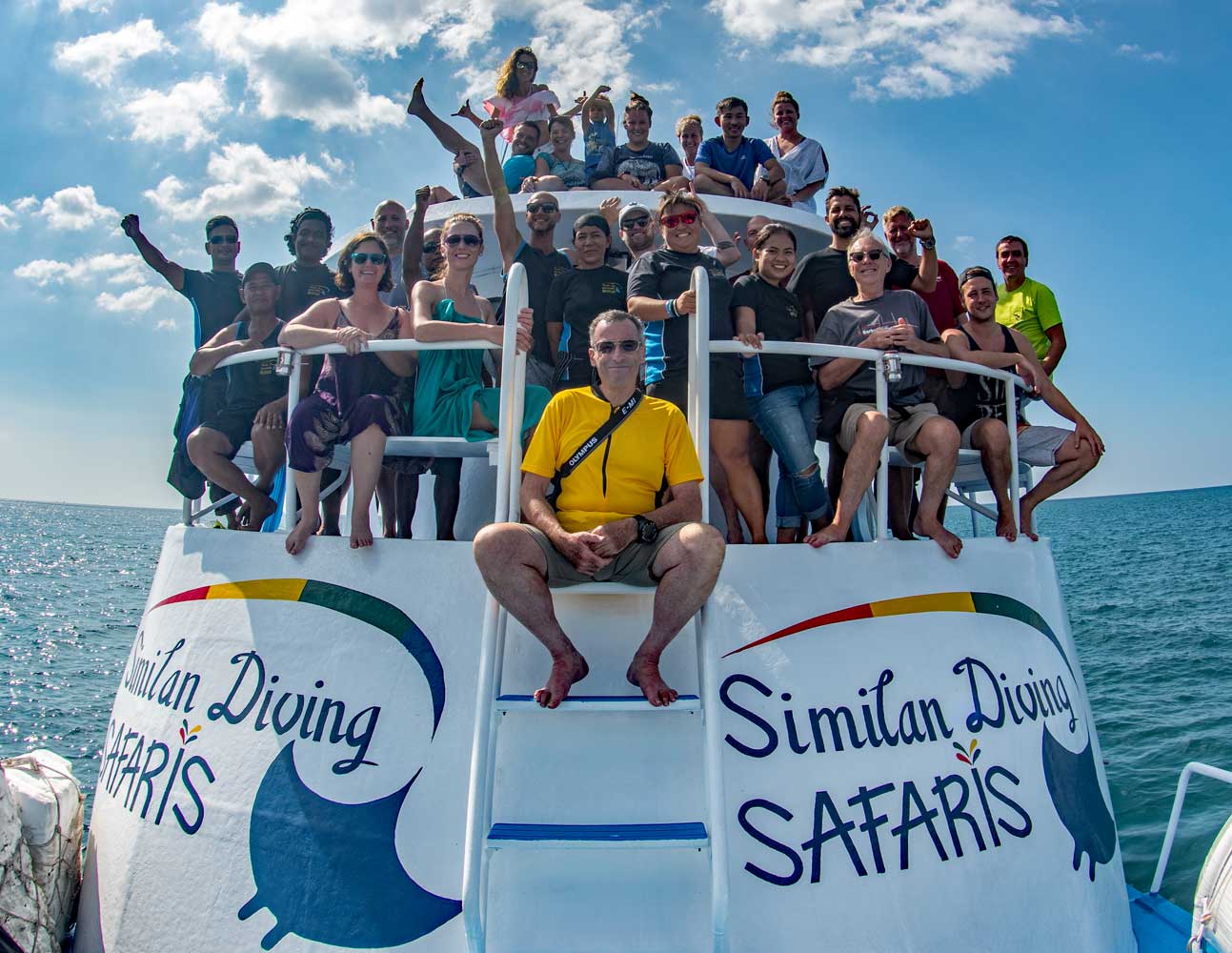
Our group
photo after all the dives; Iím in the yellow shirt in front.
Normally our dive boat would have gone back to port via the Similan Islands,
but a change in park fees made that more expensive, so we headed to Khuraburiís
port, then had more than an hourís ride in a minivan back south to the dive shop
at Khao Lak. In the evening at Khao Lak, most of got together for an Italian
farewell dinner at La Piccola Maria.
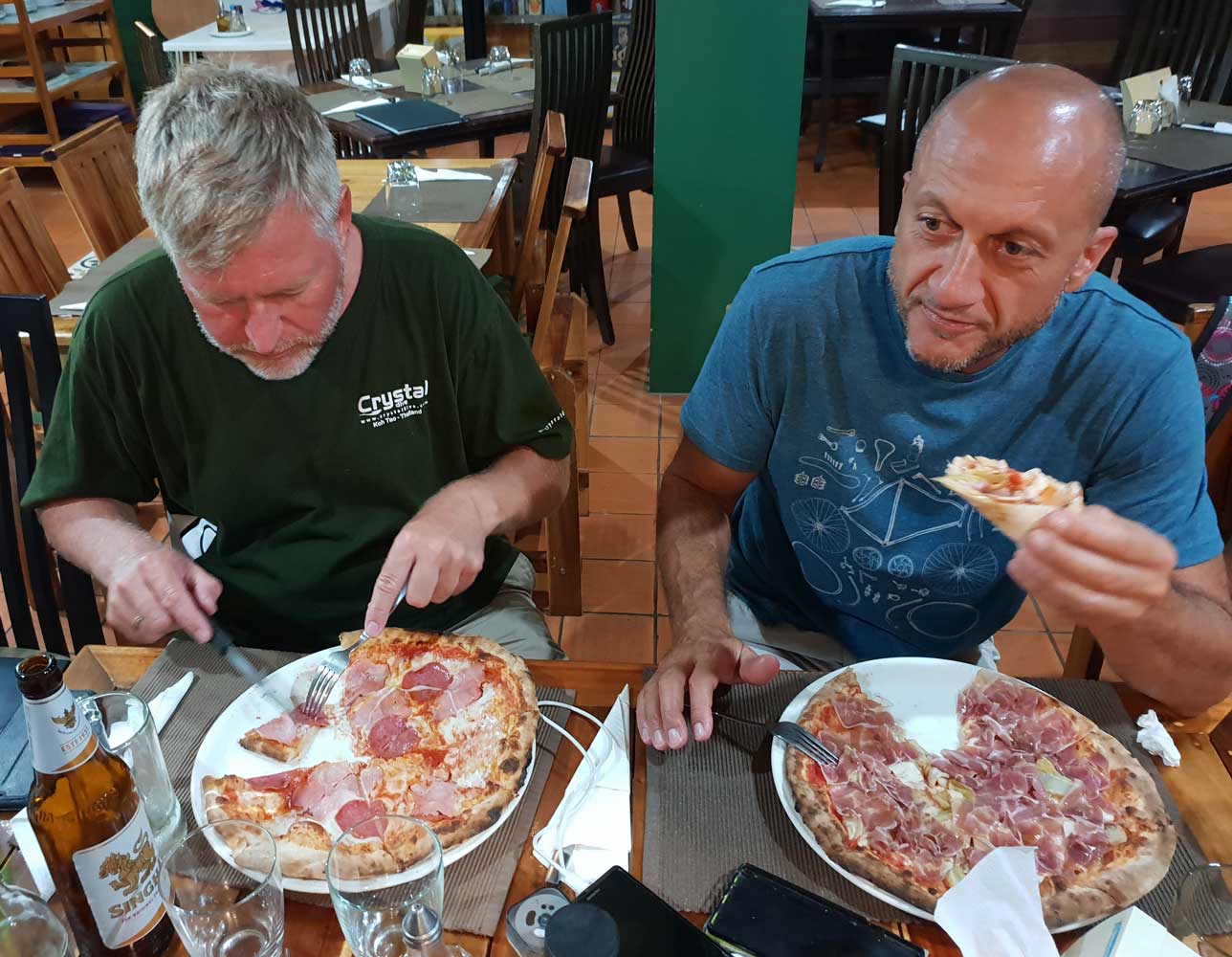 Pizza
and beer are the top items at our last dinner together.
Pizza
and beer are the top items at our last dinner together.
On to scuba diving in Thailandís Andaman Sea Part 3
Back to Beginning of Southeast Asia Backpacking Nov.-Dec. 2018









































 Pizza
and beer are the top items at our last dinner together.
Pizza
and beer are the top items at our last dinner together.